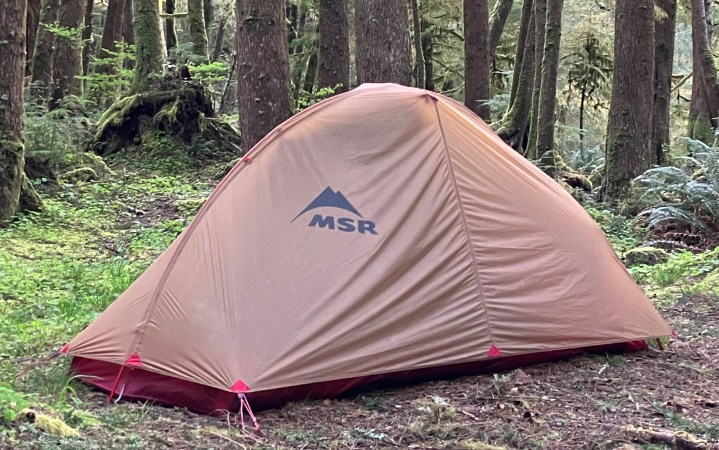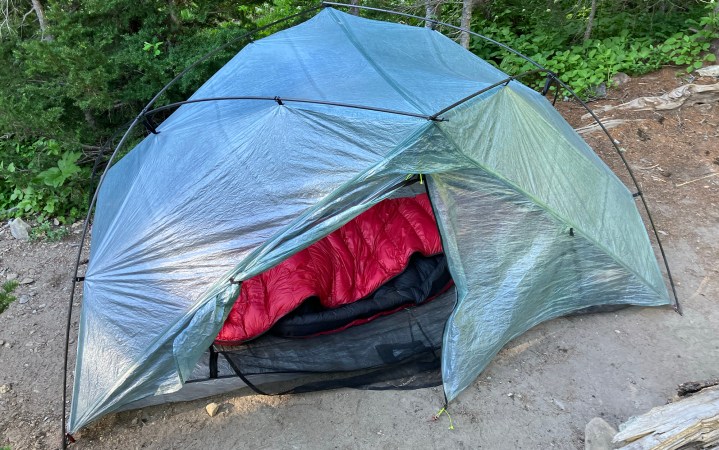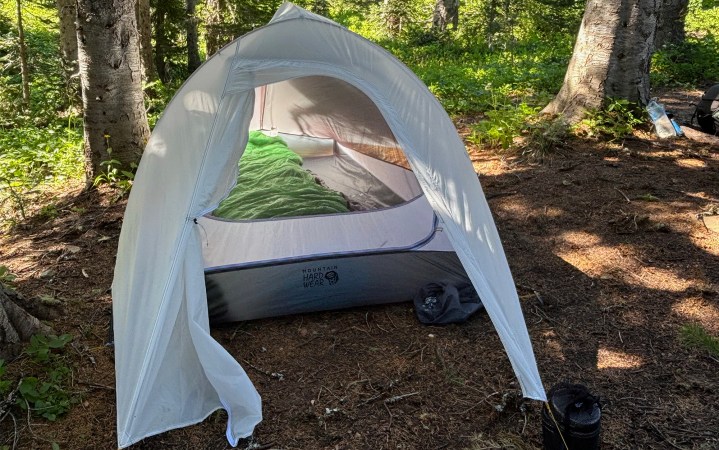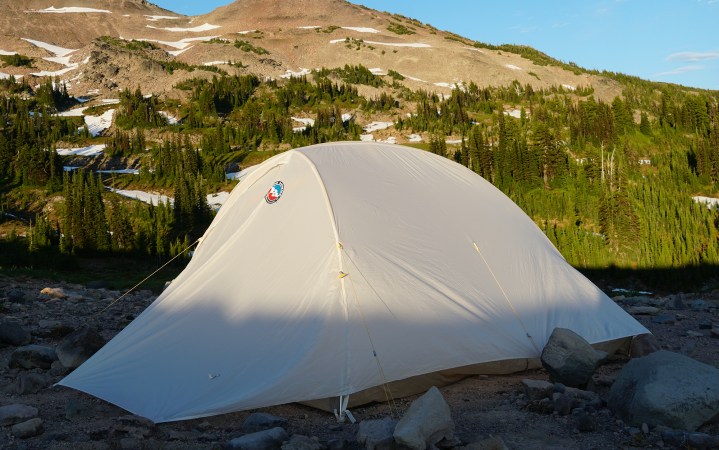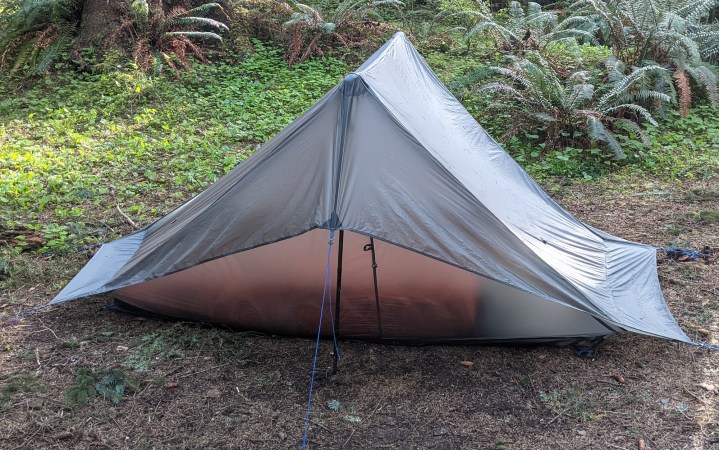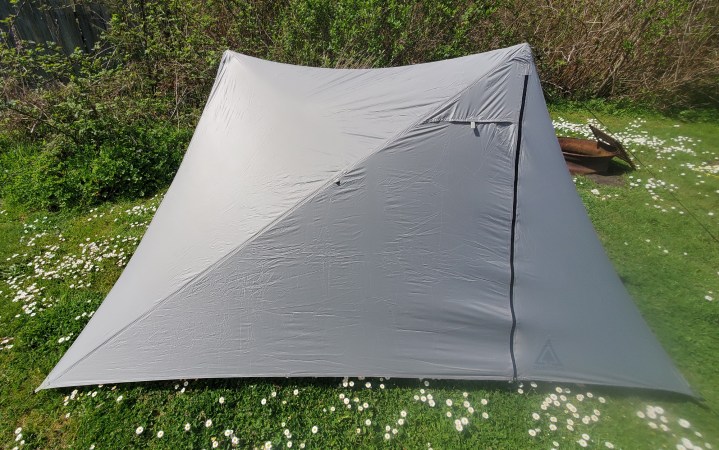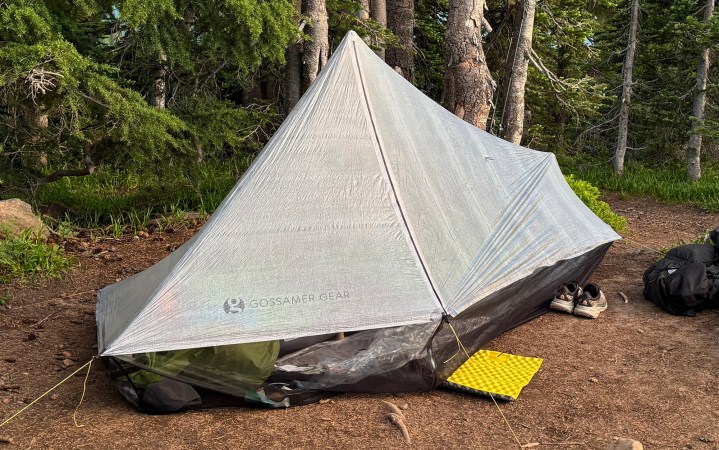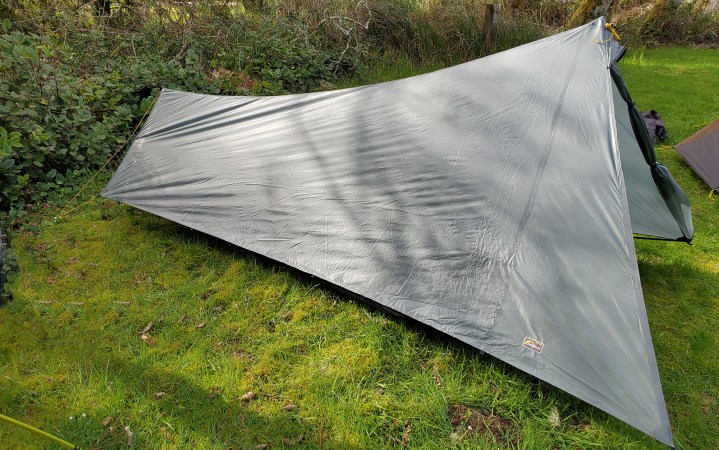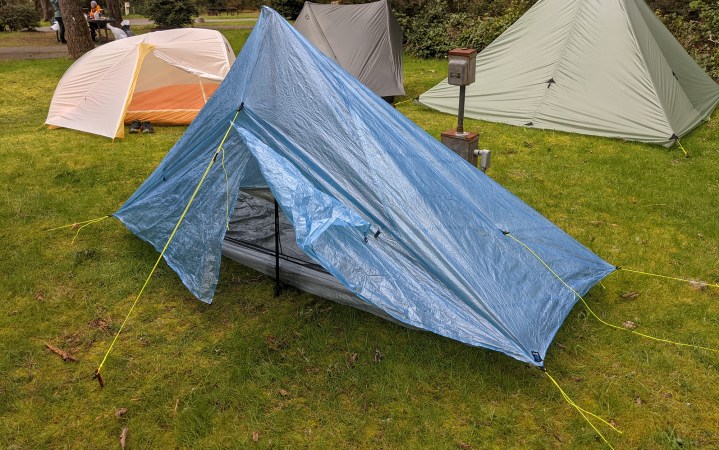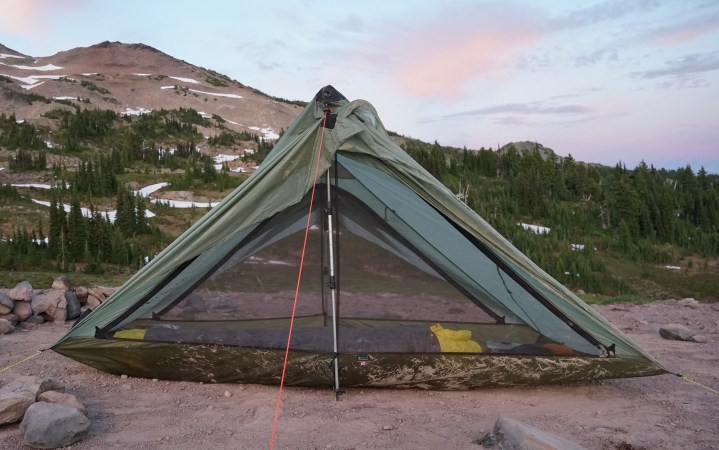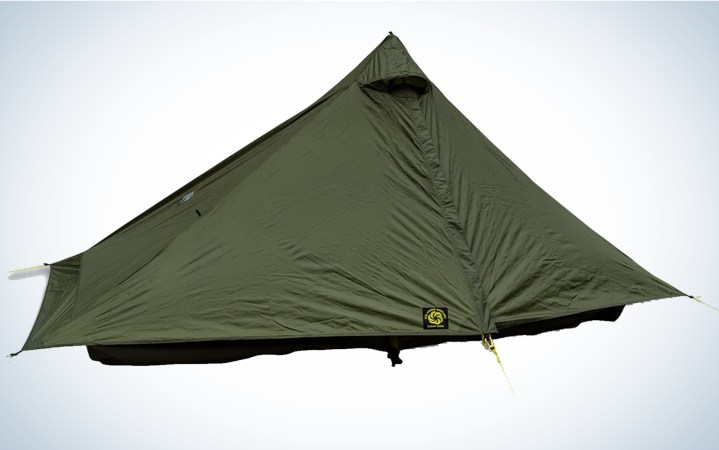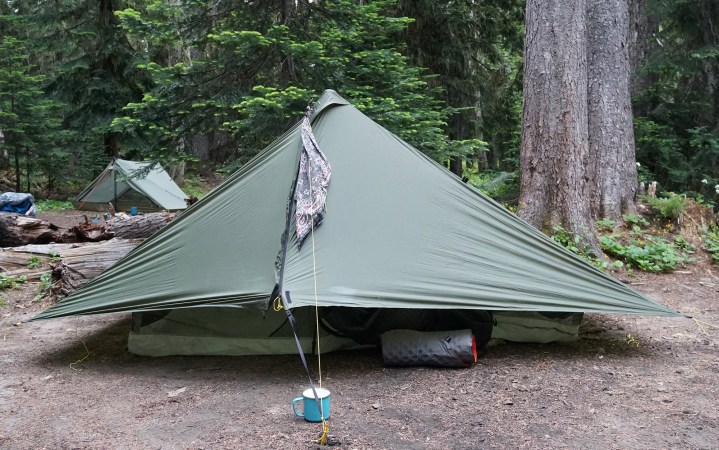The Best Ultralight Tents of 2024, Tested and Reviewed
We may earn revenue from the products available on this page and participate in affiliate programs. Learn More ›
Ultralight tents are one of the great engineering marvels: out of a sheet of wafer-thin fabric and a pair of trekking poles, you can make shelter suitable to withstand wind, rain, bugs, and more. Our only real complaint about ultralight tents is that you can’t just go to a big box showroom and see them all set up side by side. Some of the best out there are made by smaller cottage companies that simply don’t have that kind of reach. So as part of Outdoor Life’s annual backpacking gear tests, we’re taking the best ultralight tents from companies like Durston, TarpTents, Gossamer Gear, Zpacks, Seek Outside, and more out on America’s long trails to see which will impress our tester group. For the parameters of this test, we’re defining ultralight as weighing less than 2 pounds for a one-person tent or 2.5 pounds for a two-person tent.
↓ Jump to Semi-Freestanding Tents
- Best Overall: MSR Freelite
- Best Upgrade: Zpacks Free Zip
- Mountain Hardwear Nimbus UL 2
- Big Agnes Fly Creek UL 2
- Best Overall: Gossamer Gear The ONE and The TWO
- Best Value: Durston X-Mid
- Lightest: Gossamer Gear Whisper
- Best for Tall People: Tarptent ProTrail
- Zpacks Plex Solo
- Seek Outside Sunlight
- Six Moons Lunar
- Six Moons Designs Havens Ultralight
How We Tested the Best Ultralight Tents
Selection
Ultralight tents are selected across a wide range of manufacturers, from big names like MSR and Mountain Hardware to cottage companies like Seek Outside and Durston. We look at a range of tent styles — both freestanding and trekking pole — in order to get a better sense of which tents are appropriate for people of various sizes and with different experience levels.
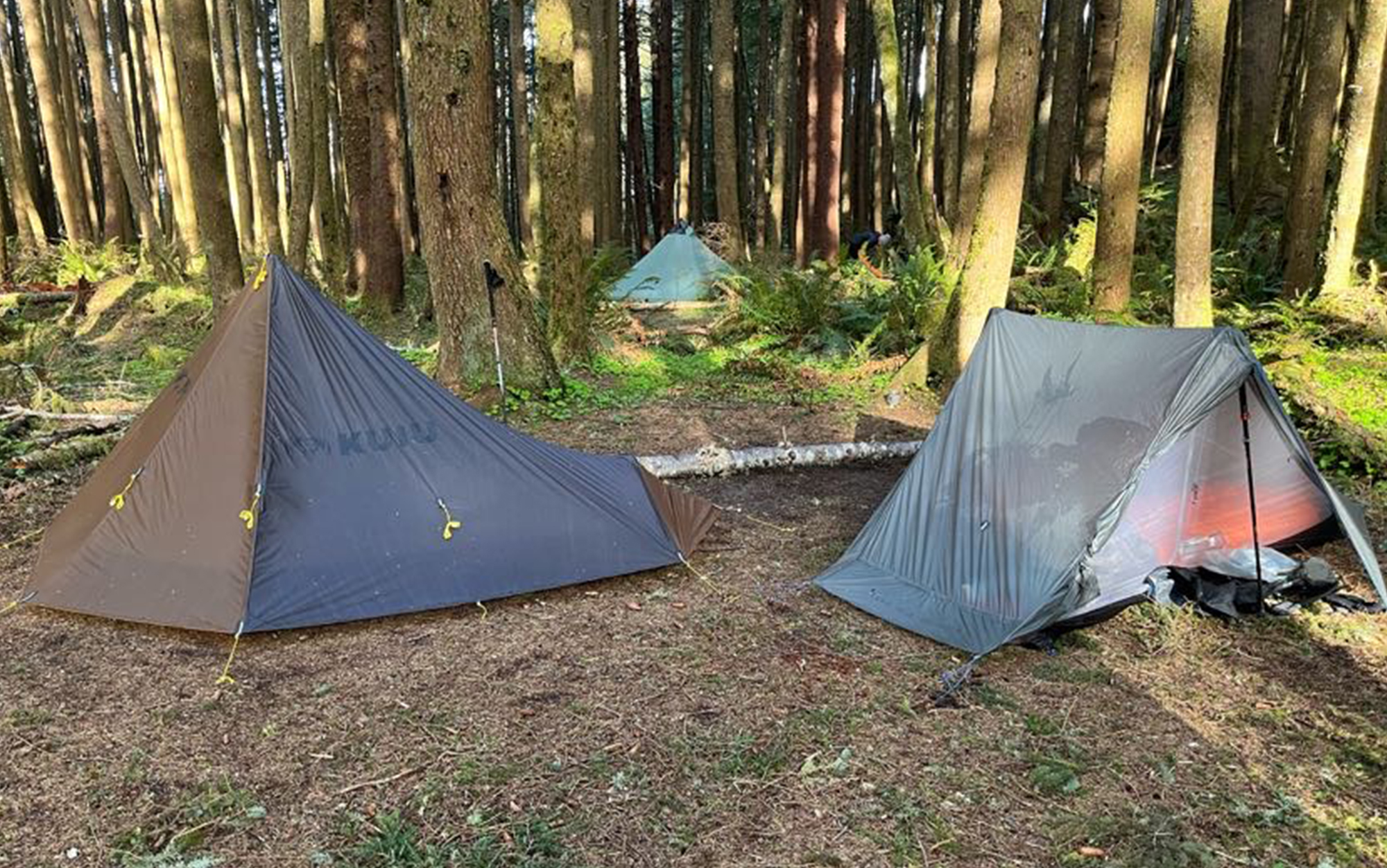
Since this review is by and for people focused on ultralight backpacking, weight is the biggest priority, followed by user feedback and, finally, price. Where some of our less experienced backpackers struggled with setup, we will note that a particular tent may require practice to set up correctly. Non-necessary features, like multiple pockets, will be mentioned but are not a ranking factor.
Tents are divided into two categories:
- Semi-freestanding tents can be put up without stakes, but will be missing some real estate on the inside. These tents should still be staked down during windy conditions and to help maximize the utility of the rainfly during downpours.
- Trekking pole tents must be staked into the ground in order to stand up. Some, but not all, gear manufacturers provide optional poles for individuals who do not use trekking poles.
Testers
To test the best backpacking tents, OL recruited a testing panel with a range of experience levels, body types, and preferences.
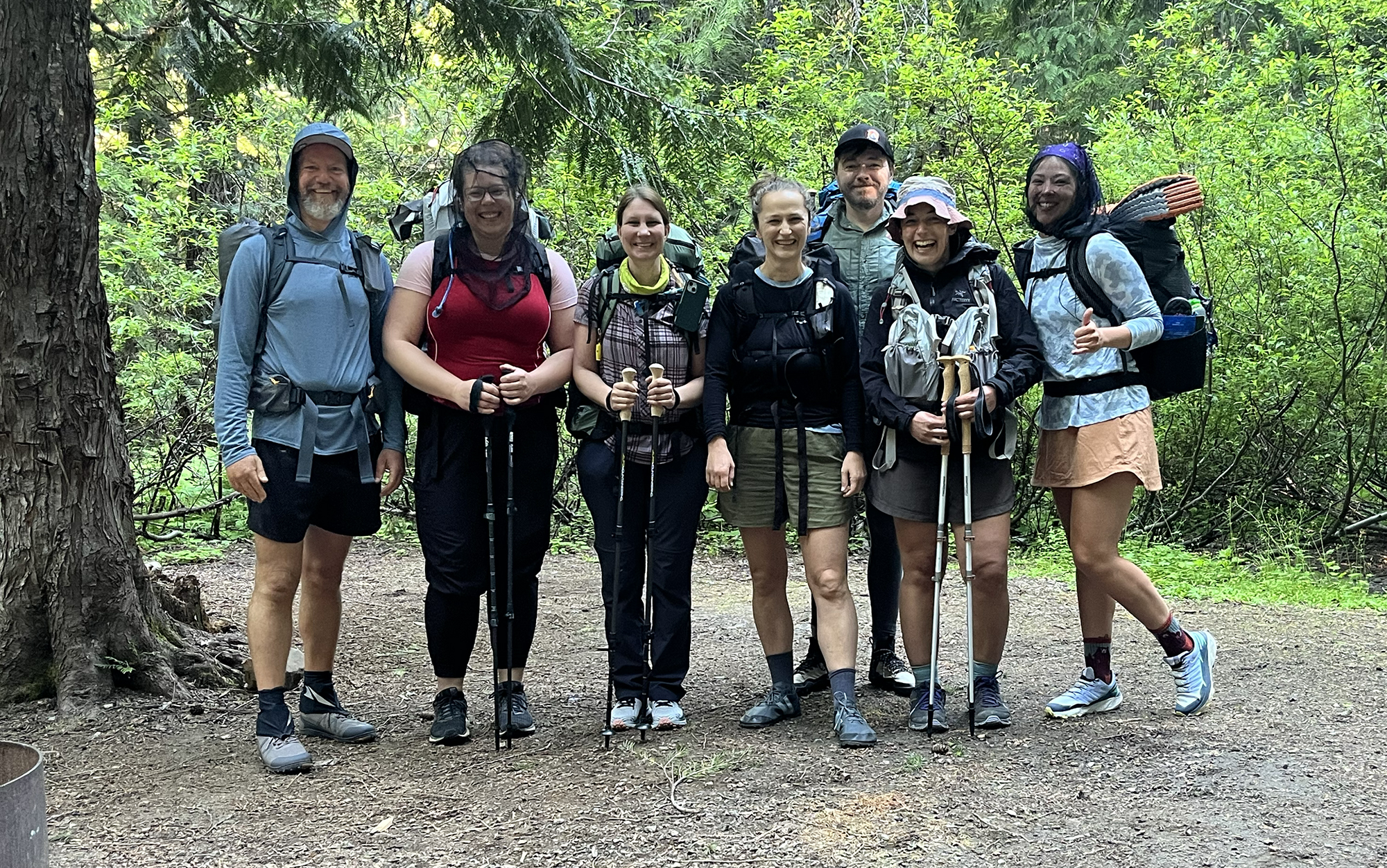
Ashley Thess
- Adam Tycaster — Over 4,000 miles of backpacking experience, including the PCT 2014 and CT 2017. Height: 6-foot-3.
- Alex Robinson — OL editor-in-chief; a backcountry big game hunter and fair-weather trail runner. Height: 6-foot-2.
- Ashley Thess — OL associate gear editor. Over 600 miles of backpacking experience. Height: 5-foot-7.
- Diana Helmuth — Author of How to Suffer Outside (National Outdoor Book Award winner). Over 1,500 miles of backpacking experience. Height: 5-foot-11.
- Jac “Top Shelf” Mitchell — Over 11,000 miles of backpacking experience including the PCT 2014, CDT 2016, AZT, 2017, and GET 2017. 5-foot-6.
- Laura “Chop Chop” Lancaster — OL staff writer. Over 4,000 miles of backpacking experience, including the PCT 2014 and CT 2017. 5-foot-5.
- Patrice “Steady” La Vigne — Gear reviewer, Denali guide, and author of Between Each Step. Over 7,000 miles of backpacking experience, including the AT 2011 and Te Araroa 2014-2015. 5-foot-5.
- Sven “Magic” Anderson — 1,350-mile LASH (PCT) 2022. Hiking with Parkinson’s disease. 6-foot-2.
Testing
Outdoor Life conducts an annual backpacking gear testing trip that focuses on innovative lightweight and ultralight backpacking gear. These testing trips take place on America’s national scenic trails, including three nights along the northernmost section of the Oregon Coast Trail and four nights on a stretch of the Pacific Crest Trail in the Goat Rocks Wilderness.
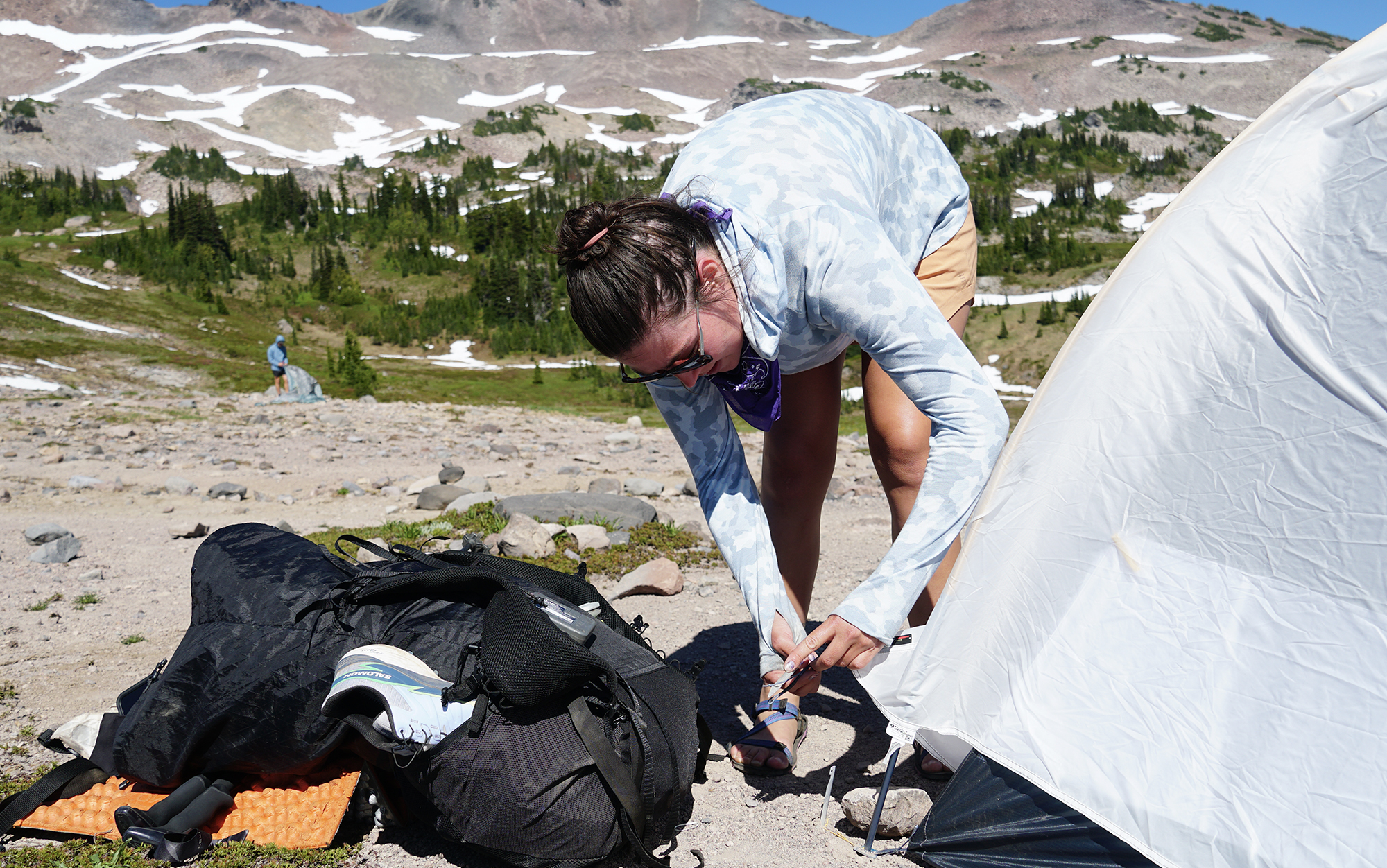
Alex Robins
These trips usually see the testing group covering 10 or more miles each day, setting up camp in environments ranging from the alpine to lowland coastal areas to deep forest. Testers receive a new tent for testing each evening, which they are responsible for setting up, sleeping in, taking down, and carrying to the next camp. Small details, like a too-small door, a sticky zipper, or difficult to use connection points can start to really jump when you compare this many tents side by side in a real-world environment. Where possible (and reasonable) testers set up their tents in less than ideal conditions to see how they would fare in the elements.
Scoring
We independently weighed the tents as used in the field. This is an important distinction, because most manufacturers only provide “packaged weight” (everything that came with the tent, including the repair kit) and “minimum weight” (just the poles, main body, and rain fly). Some cottage companies, which often sell their tents without the necessary stakes, do not provide a trail weight at all. The weights provided below more closely reflect how ultralight backpackers would use these tents: with stakes, and a few guylines. Needless to say, the weights provided in the report card vary from manufacturer-provided weights.
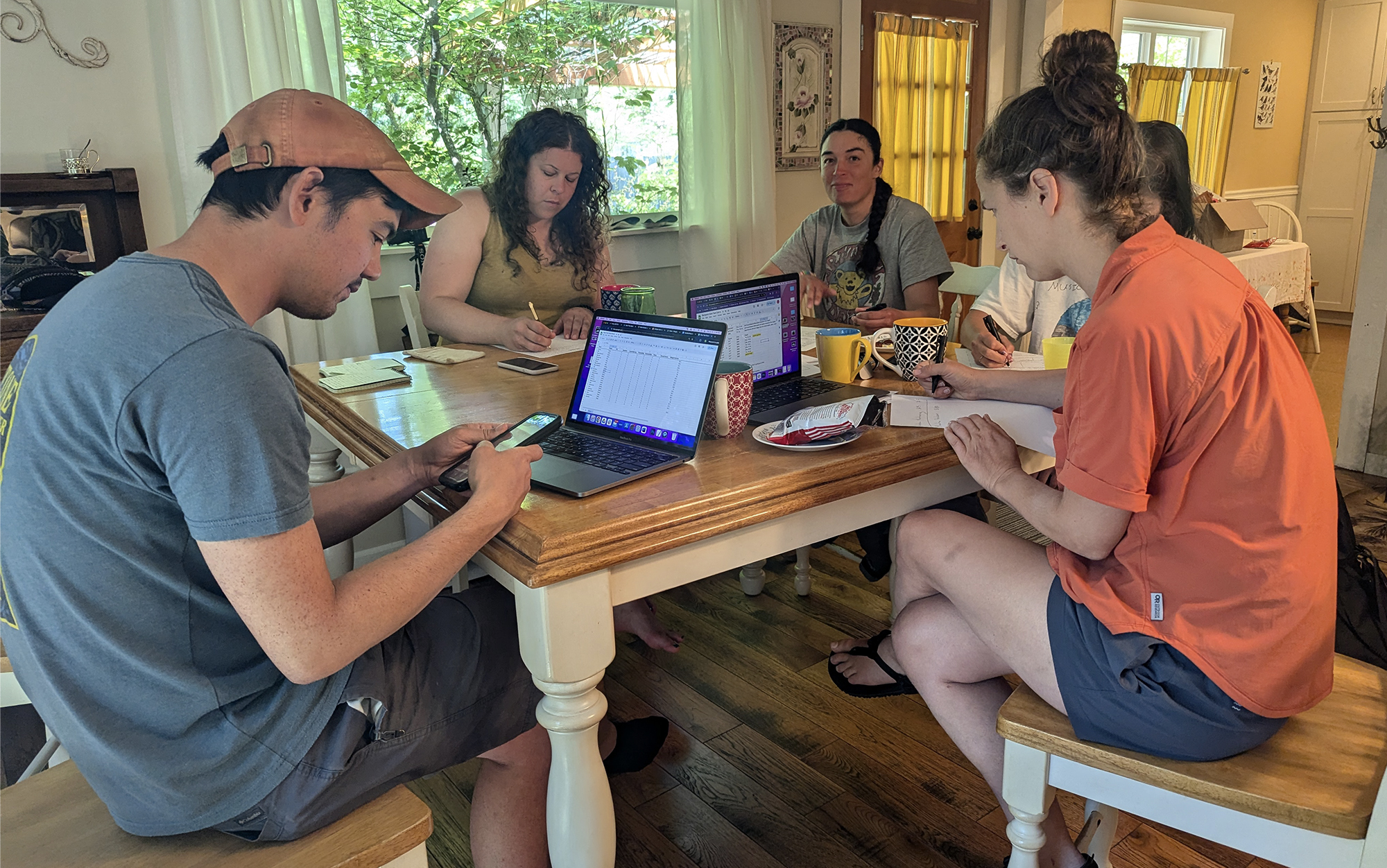
Adam Tycaster
After taking copious notes in the field, the testing team then spends a day filling out scoring sheets for each item in the test. When scoring tents, we set up each tent again so that we could compare and contrast their relative merits. We also discuss and compare with one another, which is helpful for understanding how and why experiences with the same gear can vary from person to person. Scores are then averaged among the testers, with the top scoring tents receiving top honors.
- Ease of set up: Tents were set up by multiple testers, allowing us to assess which were suitable for newbie ultralighters and which should be handled only by experienced backpackers.
- Interior living space: Most backpackers will spend eight or more hours a day sleeping — that’s a third or more of your time out on the trail. A tent that feels claustrophobic or cramped will make for a worse outdoors experience and potentially negatively affect your sleep at night. We assessed the usable space in each tent, noting how the slope of pitch or vestibule size changed our experience.
- Protection: Testers considered whether the tents they slept in provided sufficient protection from rain, wind, and condensation.
- Value: The price of an ultralight tent can vary wildly, from a couple hundred dollars to upwards of $600 — the most expensive ultralight tent we looked at costs well over a thousand. We ranked each tent on whether the setup, weight, and liveability is merited by the price point.
Interior Space
A second test we pioneered during our review of two-person ultralight tents is OL’s Two Dudes in a Tent. In our experience, a “two person tent” can mean a few different things. Sometimes it means it’s a great tent for couples. Sometimes it’s just an extra large tent for a single person. Most of the time, it will fit two women pretty well. And sometimes it will actually provide enough space for two regular sized men to sleep next to each other without things getting awkward. This test consisted of two phases. In the first, Alex Robinson and Sven “Magic” Anderson — both over 6-foot-2 — got into each tent and evaluated whether or not they would want to share it while backpacking. For those tents that failed this metric (and there were plenty of those), Ashley Thess and Jac “Top Shelf” Mitchell tested to see which they would be willing to share with one another. One note on this test is that these results are not currently available for the tents covered in OL’s first round of backpacking gear testing, which focused on one-person models.
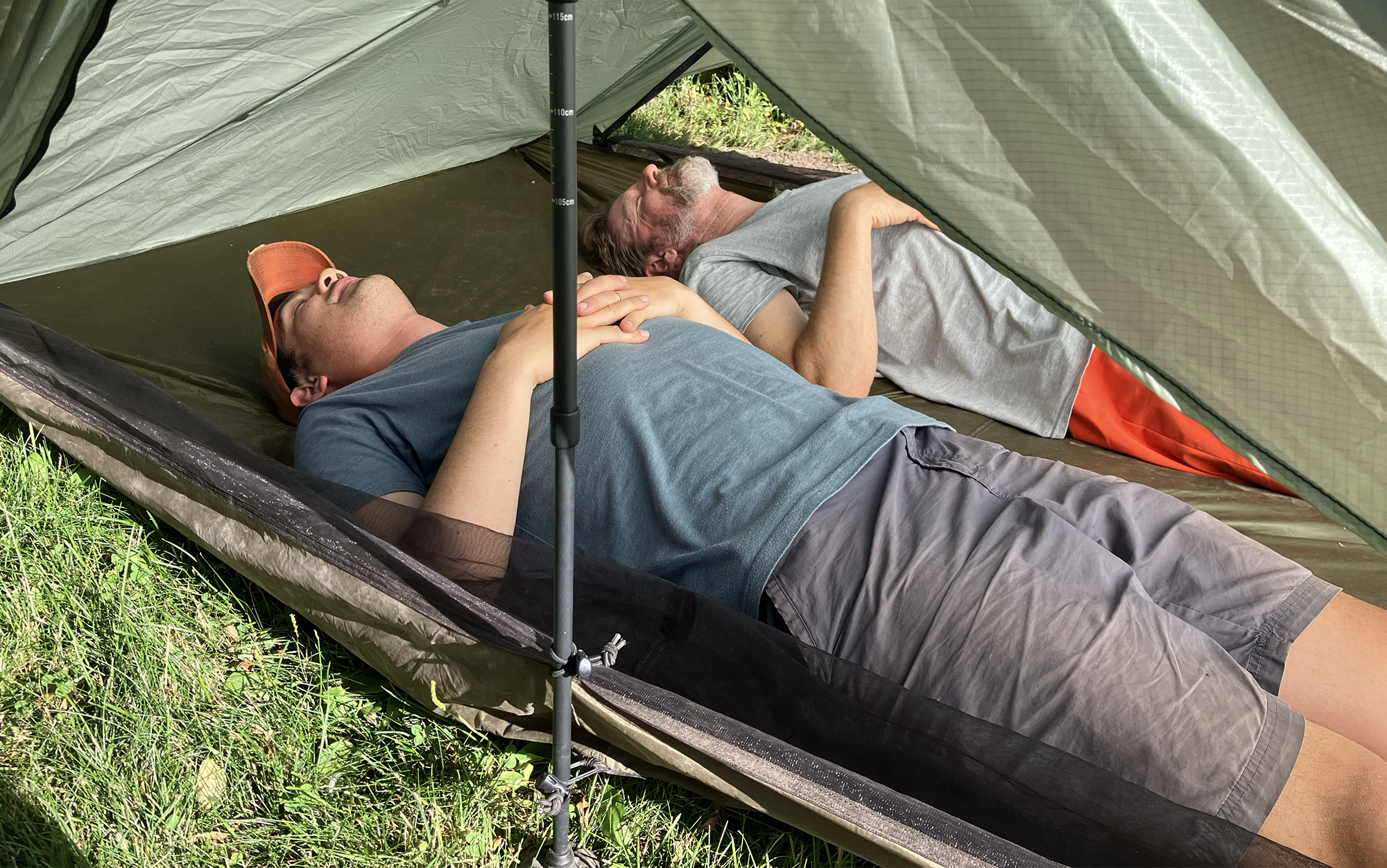
Diana Helmuth
Finally, many outdoor gear manufacturers are working on removing PFAS, a nearly ubiquitous forever chemical, from their waterproof gear as we approach the 2025 deadline set by California and New York. I queried manufacturers to see where they were in this process and have included that information below in the report card section. Generally, responses were very encouraging. Manufacturers have already made important strides in removing PFAS from the main fabrics of their tents, and are now working on getting it out of the trimmings (zippers is a big one that keeps coming up). Almost all had plans to be PFAS free by spring of 2025. Several are already there.
Comparison Table
Below is a side-by-side look at the specifications most important to ultralight backpackers (price, size, and weight) along with the average of our testers’ scores. The tent weights here come from the manufacturers; our measured weights can be found in the key features section below. Prices are current as of the date this article was last updated. Tents are organized by pitch style and listed in the order in which we recommend them.
Semi-Freestanding Tent Specs & Tester Scores
| Tent | Price | Advertised Weight | Length x Max Width (Min Width) | Setup | Interior Space | Protection | Value | |
| MSR Freelite | 1P: $420 2P: $450 3P: $540 |
1P: 1 lb, 15 oz 2P: 2 lb, 5 oz 3P: 2 lb, 11 oz |
1P: 87” x 33” 2P: 84” x 50” 3P: 84” x 66” |
5 | 3.5 | 5 | 4 | |
| Zpacks Free Zip | 2P: $900 3P: $1000 |
2P: 1 lb, 15.6 oz* 3P: 2 lbs, 4.2 oz* |
2P: 86” x 44” 3P: 86” x 60” |
4.8 | 2.8 | 3.4 | 2.4 | |
| Mountain Hardwear Nimbus | 2P: $420 | 2P: 2 lb, 4.6 oz | 2P: 86” x 52” (42”) | 4.7 | 3 | 3.7 | 3.3 | |
| Big Agnes Fly Creek | 2P: $400 | 2P: 2 lb, 4oz | 2P: 86” x 52” (42”) | 4 | 2.3 | 3 | 4.3 | |
Trekking-Pole Tent Specs & Tester Scores
| Tent | Price | Advertised Weight | Length x Max Width (Min Width) | Setup | Interior Space | Protection | Value | |
| Gossamer Gear The ONE and The TWO | 1P: $255 2P: $320 |
1P: 1 lb, 8 oz 2P: 1 lb, 11.9 oz |
1P: 84” x 33” (21”) 2P: 84” x 48” (42”) |
4 | 4.5 | 4 | 5 | |
| Durston X-Mid | 1P: $234 2P: $270 |
1P: 1 lb, 14.8 oz 2P: 2 lb, 6.4 oz |
1P: 90” x 32” 2P: 92” x 52” |
4 | 3.5 | 4 | 5 | |
| Gossamer Gear Whisper | $500 | 10 oz* | 102” x 49” (25”) | 3.6 | 3 | 2.6 | 2.6 | |
| Tarptent ProTrail | 1P: $240 | 1P: 1 lb, 8 oz | 1P: 84” x 42” (30”) | 2 | 2.5 | 3 | 4 | |
| Zpacks Plex Solo | 1P: $600 | 1P: 14.6 oz* | 1P: 90” x 38” (28”) | 2 | 2 | 3 | 3 | |
| Seek Outside Sunlight | 2P: $450 | 2P: 2 lb, 7 oz | 2P: 99” x 60” (50”) | 4 | 4.8 | 4.3 | 3.8 | |
| Six Moon Designs Lunar | 1P: $260 | 1P: 1 lb, 12.4 oz* | 1P: 90” x 48” | 4 | 3 | 4 | 4 | |
| Six Moon Designs Haven | 2P: $375 | 2P: 2 lb, 4.3 oz | 2P: 88” x 44” | 1.2 | 4 | 3.8 | 4.3 | |
Best Ultralight Tents: Semi-Freestanding
Best Overall: MSR Freelite
One-Person Model Tested on the Oregon Coast Trail by Diana Helmuth and Jac “Top Shelf” Mitchell
Report Card
- Ease of Setup: 5
- Interior Living Space: 3.5
- Protection: 5
- Value: 5
- Measured Weight of the 1-Person Model: 1 pound, 14.5 ounces (half an ounce less than advertised)
- PFAS free
Key Features
- Max Head Height: 39 inches (1P & 2P), 43 inches (3P)
- Doors: One door (1P), two doors (2P & 3P)
- Materials: Ripstop nylon
- Warranty: 3 years
- Price: $420 (1P), $450 (2P)
Pros
- One of the lightest semi-freestanding tents we tested
- Length on the 1-person model makes it a reasonable choice for individuals up to six feet tall
- Easy to set up
Cons
- Less width than other tents we’ve looked at
If you’re kitting out your first ultralight setup, this is one to have on your radar. Our tester group was impressed with how easy and quick it was to set up the MSR Freelite — one tester set it up in under two minutes without having used it before. The interior of the one-person model, while not exactly spacious, was large enough for the biggest sleeping pad on our test (a full-size rectangular Therm-a-Rest NeoAir Xlite NXT), with a backpack fitting handily into the vestibule. Testers reported that it felt larger than it was, which is an important detail if you get stuck inside waiting out a storm. The mesh and fly were extremely lightweight and plenty robust, with the dirt falling right off when we shook it out before stuffing it away for the day. The poles were even made from aluminum, as opposed to splinter-prone carbon fiber. Our only concern was with that 15D bathtub floor — it may benefit from a groundsheet on more challenging terrains — but this was strictly theoretical as we didn’t experience any holes on our testing trip.
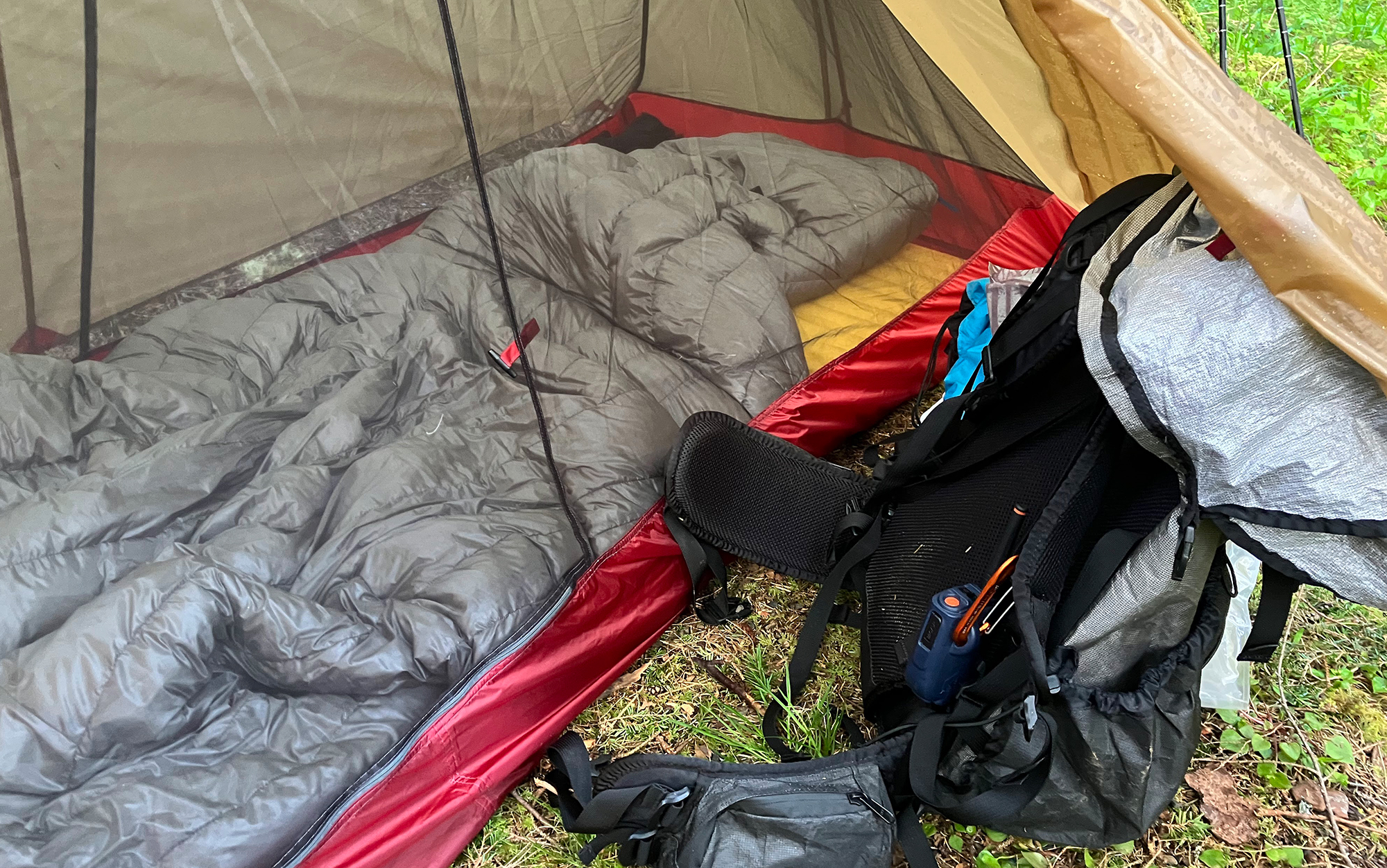
While some ultralight backpackers prefer the weight savings of a single-wall tent, the extreme condensation of the Oregon Coast showed the advantages of a double-wall setup. While the rest of our testing team was carefully packing up for the day, avoiding the soaked sides of their single-walled tents lest they unleash a rainstorm on their sleep system, the tester in the MSR Freelite 1 could sit up, bump their head on the mesh at the top of the tent, and stay dry.
There are only a few small quibbles with this tent. One is the door: It’s on the small side compared to the rest of our field, forcing our tallest tester (5 feet, 10 inches) to pretzel her limbs more than she would have liked when getting out. The included stakes (needle stakes) are also lower quality compared to other options in the MSR arsenal. Consider upgrading to either the lightweight MSR Carbon Cores or the MSR Groundhog Minis, which have great holding power.
Best Upgrade: Zpacks Free Zip
Two-Person Model Tested in the Goat Rocks Wilderness by Jac “Top Shelf” Mitchell, Laura “Chop Chop” Lancaster, Diana Helmuth, and Sven “Magic” Anderson with additional input from Ashley Thess
Report Card
- Ease of Setup: 4.8
- Interior Living Space: 2.8
- Protection: 3.4
- Value: 2.4
- Measured Weight of the 2-Person Model: 2 lbs, 3.4 oz (3.8 oz heavier than advertised; advertised weight did not include stakes)
- PFAS free
Key Features
- Max Head Height: 43 inches (2P & 3P)
- Doors: 2 (2P & 3P)
- Materials: Dyneema
- Warranty: 2 years
- Price: $900 (2P), $1000 (3P)
Pros
- Very storm worthy
- Lightweight
Cons
- No vestibule
- Tight squeeze for two people
- Expensive
OL Associate editor Ashley Thess raved about the tent she used on the Tour du Mont Blanc, and, after our testing team had the chance to check out the Zpacks Free Zip, we can see why. Like all semi-freestanding ultralight tents, it takes very little time to set this one up. Unlike other semi-freestanding ultralight tents, you get a surprisingly bombproof pitch with very little tweaking.
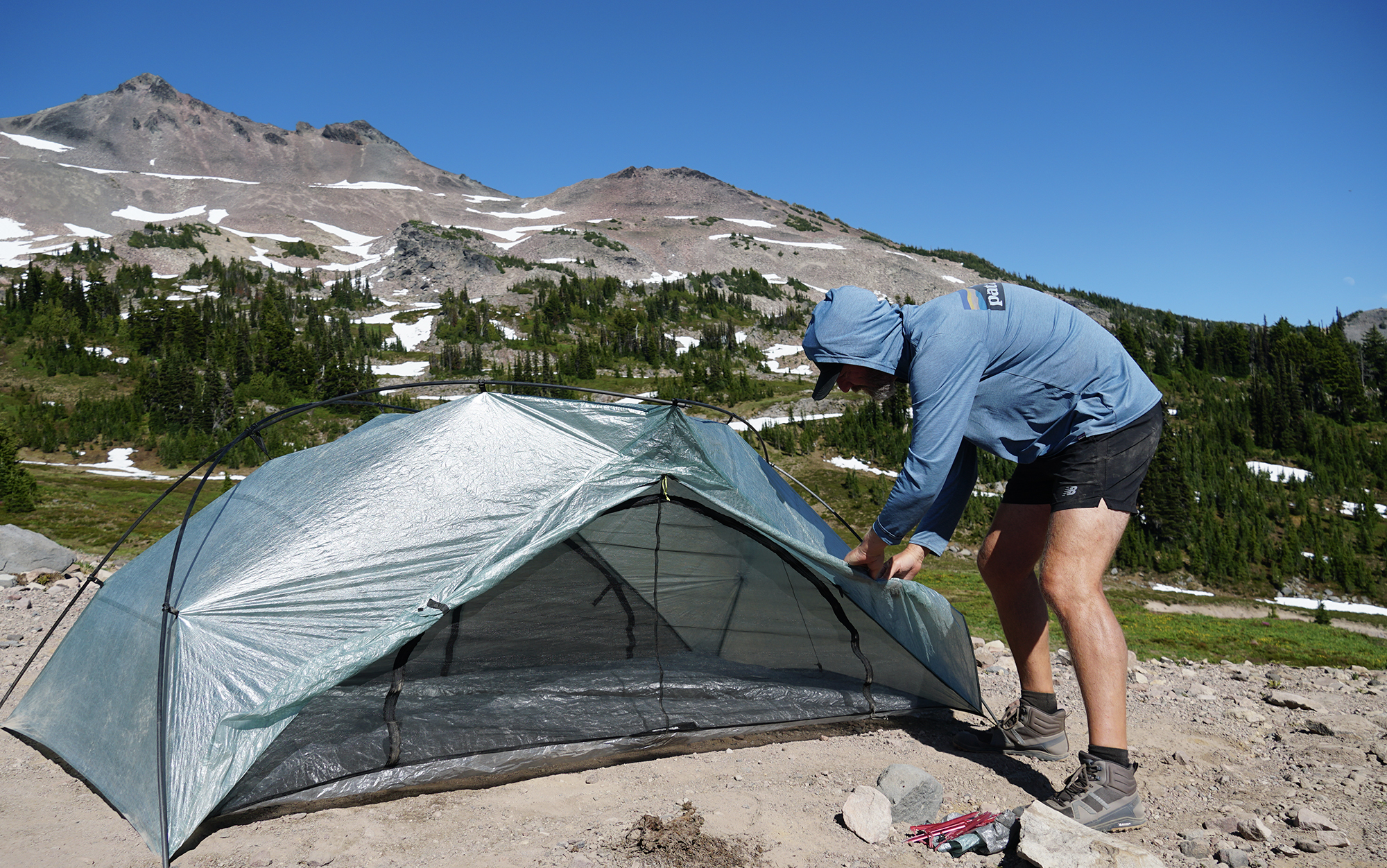
Credit: Alex Robinson
Unusually for an ultralight tent, there are four separate pole sections, all the same length. Two poles crisscross to form an X on each side, creating the structure of the tent. All our testers found this to be simple and intuitive. Helmuth, who struggled mightily with the Zpacks Plex Solo, rated the Free Zip a 5 for setup; in fact, it had nearly perfect scores across the board.
In our experience, while it is possible to set up the Zpacks Free Zip without stakes, our testers aren’t recommending it. First off, the tension from the two opposing cross-pole sections wants to clamshell the tent, which is annoying. But even once you get inside it and force the tent shape down with your body weight, you’re going to be missing some floor real estate. The stakes are also essential if you are planning to use this tent in exposed or windy conditions. But once it was properly staked out, testers were impressed with its stormworthiness, with one noting that it “felt like it could withstand a hurricane.”
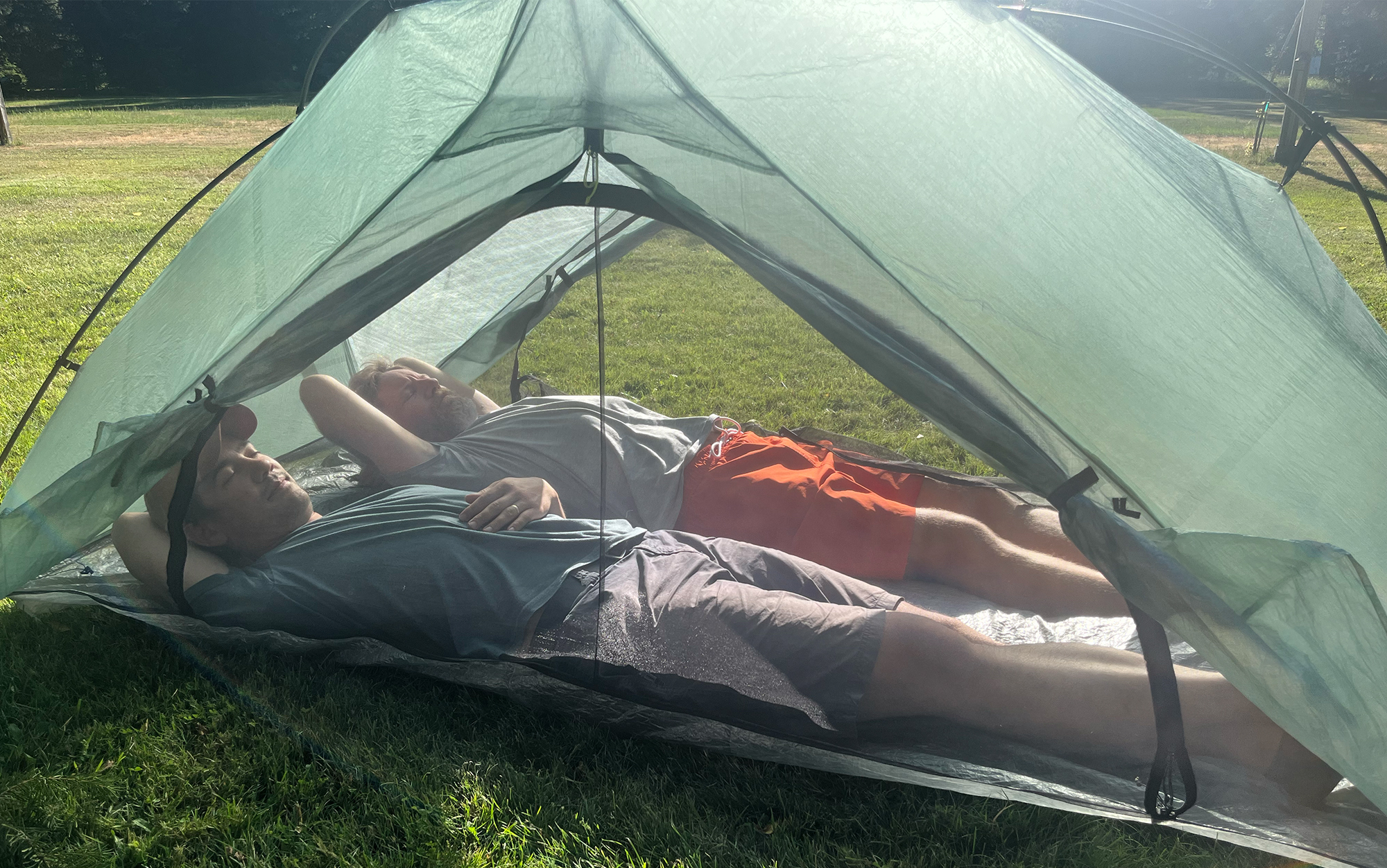
Ashley Thess
Whether or not you think the Free Zip has enough interior space depends on your expectations from an ultralight tent. Zpacks rates the smaller model of this tent as being for one to two people (and the larger as being for two to three). Our experience supports this recommendation. While two medium-sized women with ultralight kits were able to fit into this tent together, this one did not pass our Two Dudes in a Tent test. Another consideration with this tent is condensation. Like all single-wall tents, it’s prone to collecting moisture on the interior, but when fully zipped up it’s even more prone than most: it was one of the few tents on our Goat Rocks Wilderness trek to struggle with condensation (on the second night, while camped next to a river). The lack of vestibules makes this an additional challenge.
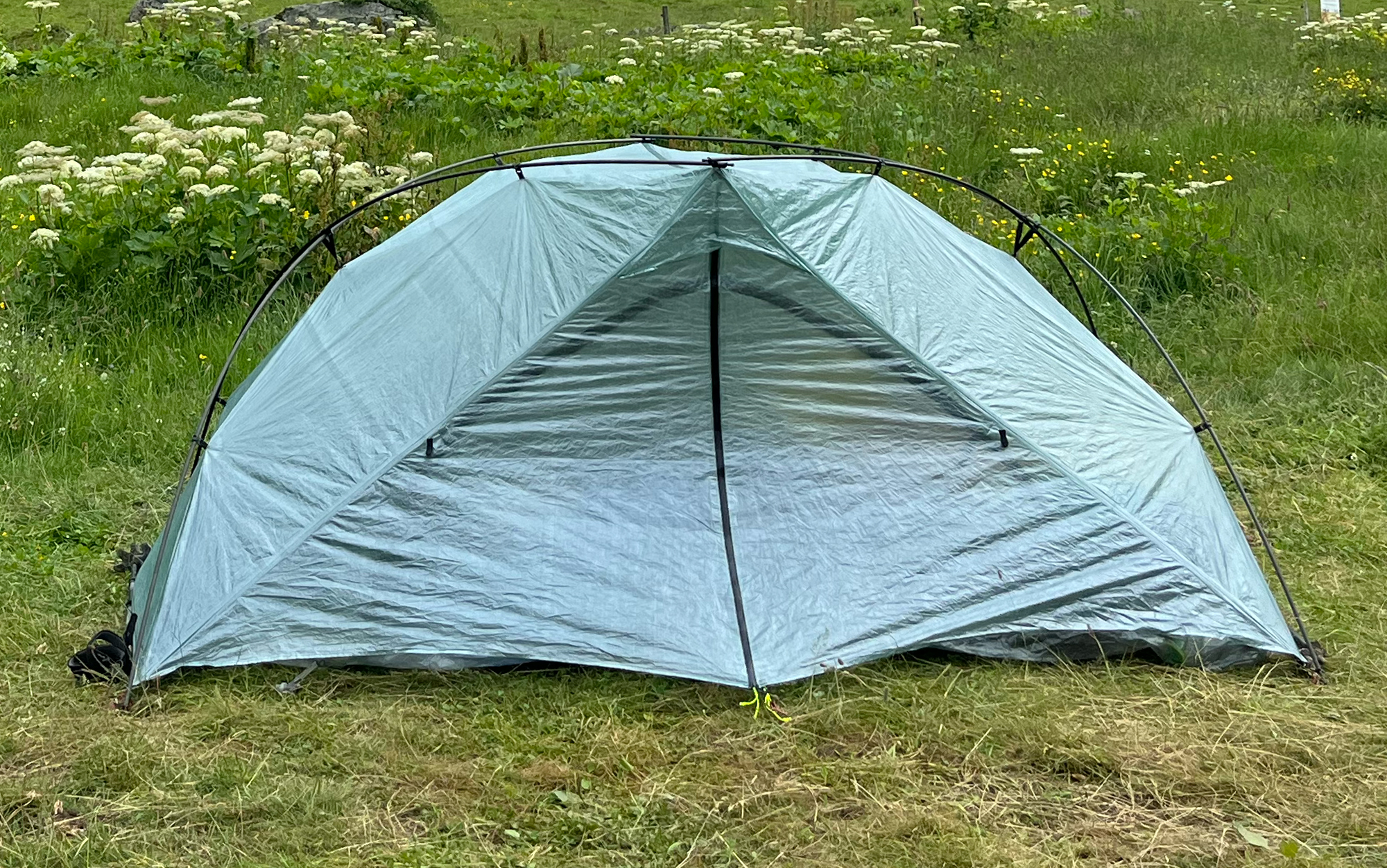
Ashley Thess
The small size of the vestibules are perhaps one of the most noteworthy features of this tent. Their taut design is part of what makes them so stormworthy; however, it also means that you aren’t going to fit much more in there then your shoes. Whether that’s a dealbreaker or a non-issue for you will depend on the size of your existing kit. Magic also noted that the low entrance to this tent was difficult to get in and out for him, due to stiffness from Parkinson’s.
We can’t end this review without mentioning the price. It’s very high (certainly partly due to the high cost of Dyneema and carbon fiber), and likely out of reach for most ultralight backpackers.
Read our full review of the Zpacks Free Zip Tent for more information.
Mountain Hardwear Nimbus UL
Two-person model tested in the Goat Rocks Wilderness by Patrice “Steady” La Vigne, Adam Tycaster, Ashley Thess with additional input by Laura “Chop Chop” Lancaster
Report Card
- Ease of Setup: 4.7
- Interior Living Space: 3
- Protection: 3.7
- Value: 3.3
- Measured Weight of the 2-Person Model: 2 pounds, 3.7 ounces (0.9 ounces less than advertised)
- PFAS free
Key Features
- Max Head Height: 41 inches (2P)
- Doors: One door (2P)
- Materials: Ripstop nylon
- Warranty: Limited lifetime
- Price: $420 (2P)
Pros
- One of the lightest non-trekking pole tents we’ve tested
- Easy to set up
Cons
- Front entry was not popular with testers
- 2-person model was not large enough for two people
I checked out the one-person version of this tent as part of my scouting for the second annual OL backpacking gear test and came away impressed. It set up fast and was lightweight with a small packed size (essential when you’re carrying the Palante Desert, one of the best ultralight backpacks). It wasn’t the most home-like tent I had ever used, but it felt safe and secure and, to be honest, I don’t like to spend time in my tent, anyway.
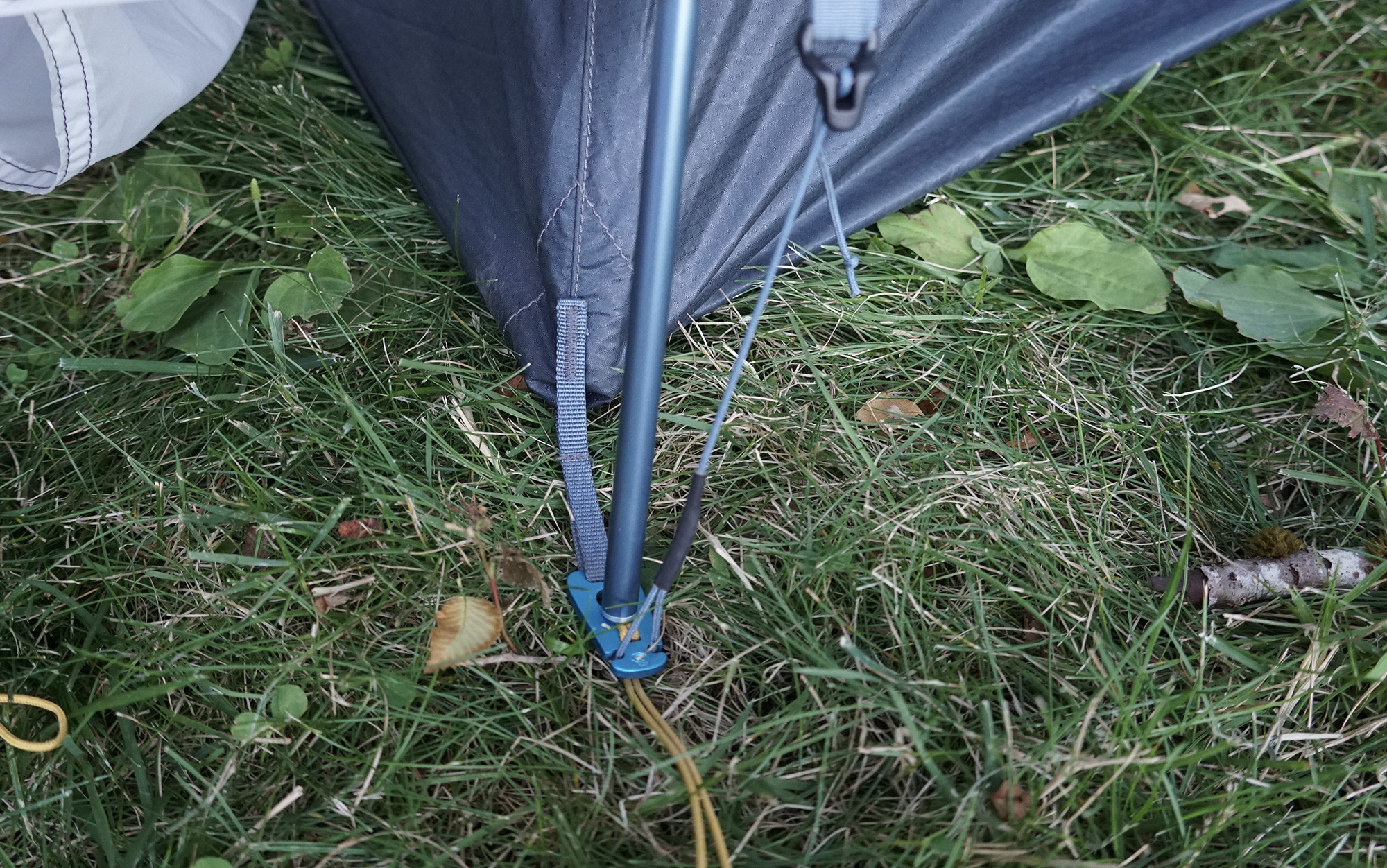
Alex Robinson
The tester panel for the backpacking gear test used the two-person version of the Mountain Hardwear Nimbus. Let’s start with the bad: for a two person tent, they were not impressed by the interior space it provided, with multiple testers noting that it felt cramped and they would not want to share it with a second person. When we ran our Two Dudes in a Tent test on this one, it was the only tent that our two gal testers told us was too small to use. (Tycaster, our tallest tester, did like the two-person for just himself.) Testers were similarly nonplussed by the front entry door. While it does provide some weight savings, it cuts the number of possible vestibules down from two to one. It also means that you enter the tent at the top of your sleeping area, which plenty of people find awkward.
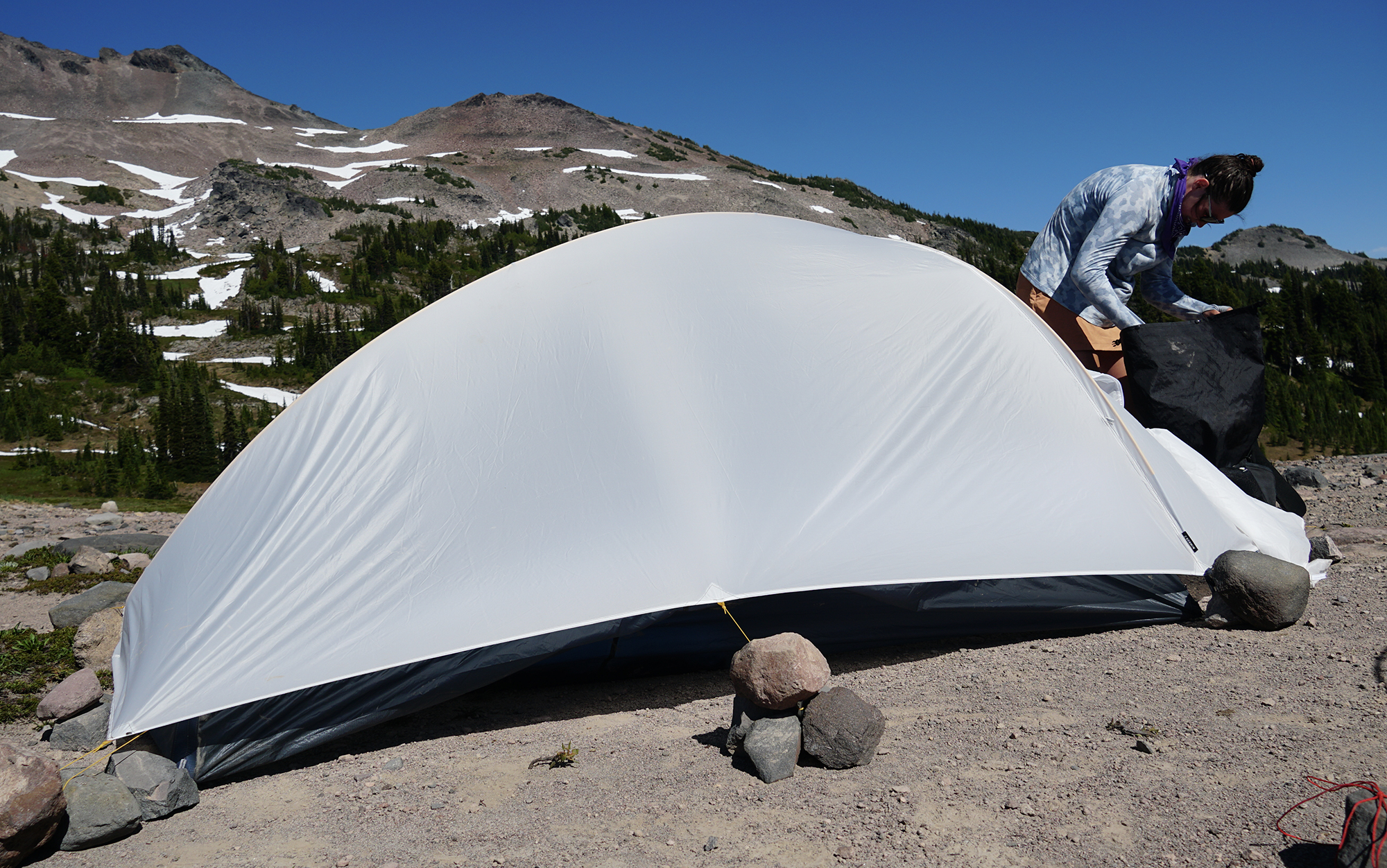
Alex Robinson
But testers did appreciate how easy it was to set up and take this down (no instructions needed for this group), especially compared to the trekking pole and other non-freestanding tents we looked at. Steady mentioned that, when attaching the rainfly to the main body, “the hooks were so small, they were a little difficult to secure without effort.” Thess reported that the tent, even when fully staked out, flapped around substantially in heavy winds. This one is a better bet for backpackers willing to hike a few miles past that ridgeline to reach the safety of the trees.
One characteristic of this tent that testers were torn on was the white fabric. It tended to pick up dirt easily, but also made the tent more visible in low light conditions.
Big Agnes Fly Creek UL
Two-person model tested in the Goat Rocks Wilderness by Alex Robinson, Adam Tycaster, and Sven “Magic” Anderson
Report Card
- Ease of Setup: 4
- Interior Living Space: 2.3
- Protection: 3
- Value: 4.3
- Measured Weight of the Two-Person Model: 2 pounds, 4.7 ounces (.3 ounces less than advertised)
- PFAS free in 2025
Key Features
- Max Head Height: 42 inches (2P)
- Doors: One door (2P)
- Materials: Ripstop nylon
- Warranty: Limited lifetime
- Price: $400 (2P)
Pros
- Less expensive than other tents on this list
Cons
- Heavier than other tents we looked at (although still very lightweight)
- Front entry can be more awkward to get into
The Big Agnes Fly Creek is a similar design to the Mountain Hardwear Nimbus, and testers’ feedback on this tent reflected as such. The front-end entry was frustrating, but setup and takedown was easy enough. Despite the tent coming in at a lower price point than the Nimbus, testers rated it less favorably, including the tester, Tycaster, that used both tents. He and Magic both noted that the vestibule was small and that the interior was oddly claustrophobic with the sides tending to sag. “The interior felt like a coffin,” said Tycaster. While he was our tallest tester, these are not the results you want for a two person tent. It’s worth noting that, in our Two Dudes in a Tent test, testers reported that two women can fit into the two-person version just fine.
Best Ultralight Tents: Trekking Pole
Best Overall: Gossamer Gear The ONE and The TWO
One-person model tested on the Oregon Coast Trail by Diana Helmuth and Ashley Thess
Report Card
- Ease of Setup: 4
- Interior Living Space: 4.5
- Protection: 4
- Value: 5
- Measured Weight of the One-Person Model: 1 pound, 6.6 ounces (1.4 ounces less than advertised)
- PFAS free in 2025
Key Features
- Max Head Height: 45 inches (1P), 43 inches (2P)
- Doors: One door (1P), two doors (2P)
- Materials: Ripstop nylon
- Warranty: One year
- Price: $255 (1P), $320 (2P)
- Optional aluminum pole sets available (5.7 ounces for a pair)
Pros
- Easy to set up
- Reasonably priced
- Good sized interior that felt homey to our testers
Cons
- Technically a smaller footprint than comparable models
The Gossamer Gear The One is the total package. It’s easy to set up, even for first-time trekking-pole tent users. It’s very light. It has enough head room to move around comfortably in the morning. The vestibule fit all our gear with room to spare. It packs up small. It even had an interior stow pocket for odds and ends like eyeglasses. Check. Check. Check.
Read Next: The Best Trekking Poles
But this is the real reason it won the top slot: The Gossamer Gear The One, more than any other tent in our test, just had that je ne sais quoi that we look for in our home on the trail. Our testers wanted to be in this tent at the end of the day and were happy to wake up in it in the morning — even our tallest tester at 5 feet, 10 inches. There was more wrangling to be the next tester for this tent than of any other we looked at.
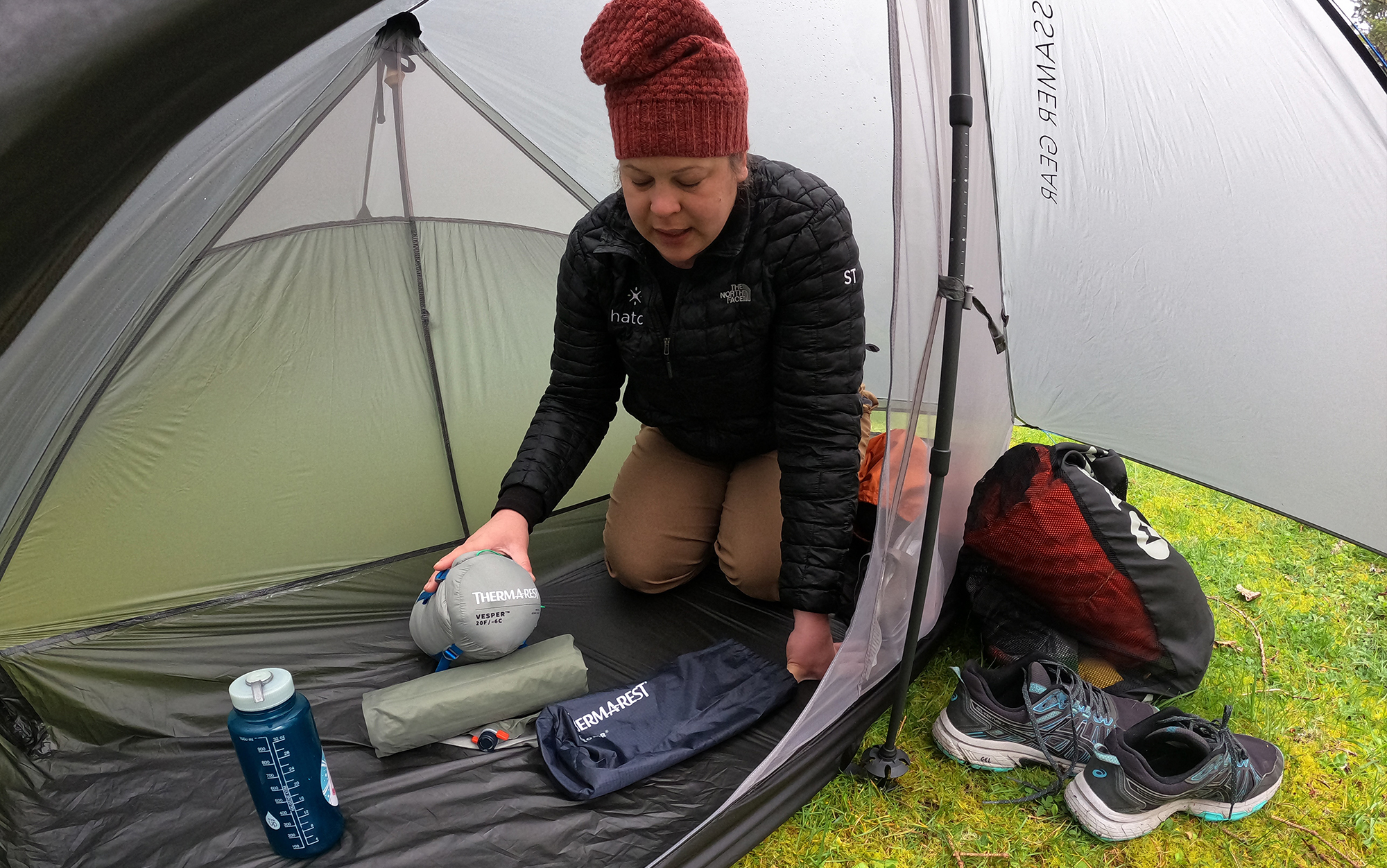
Both testers who took this tent out reported that they were able to figure out how to set up the tent without directions (something that was decidedly not true for all the trekking-pole tents in our test). However, they both noted the lack of directions provided in the package — consider downloading these to your smartphone before heading out into the field.
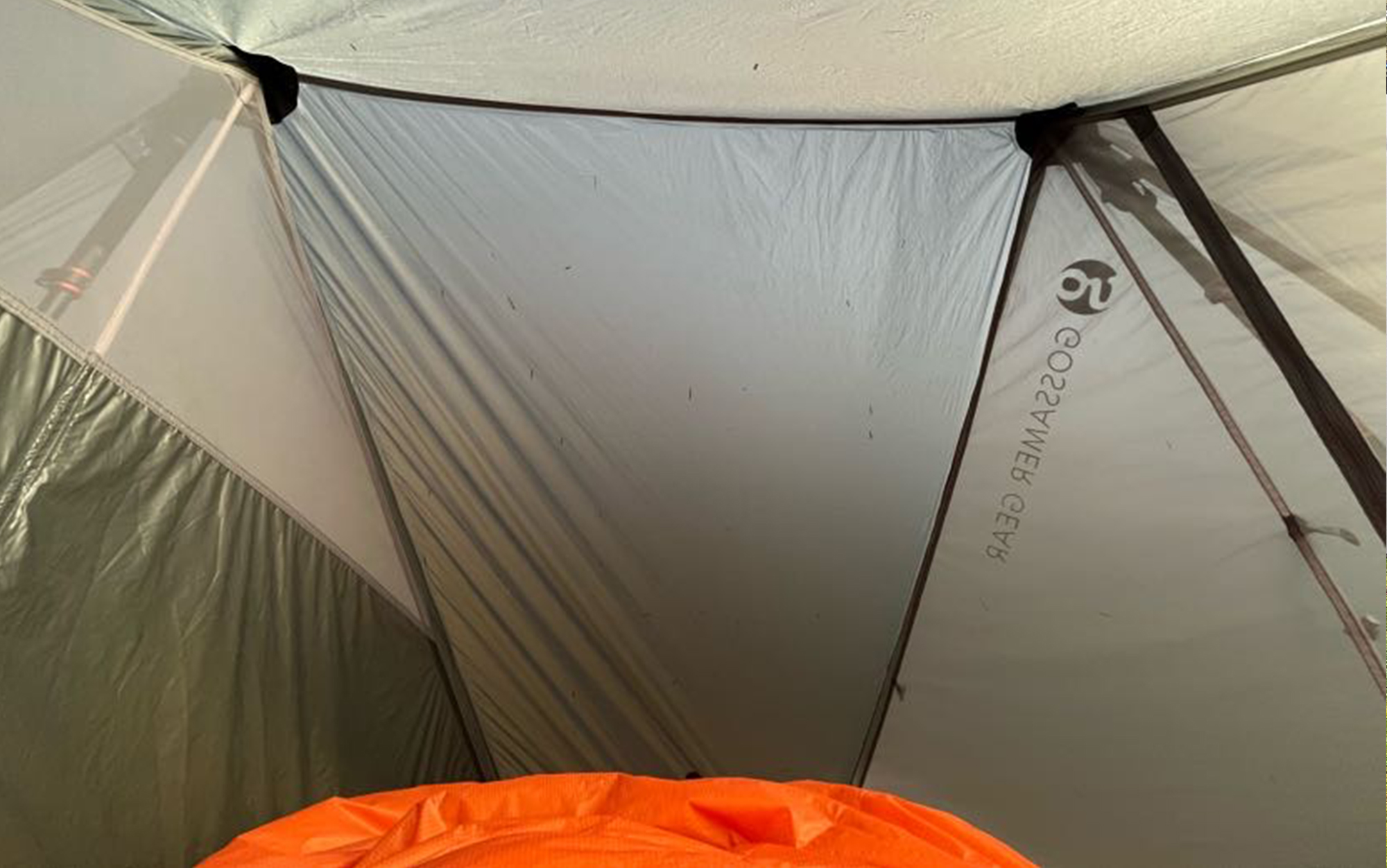
The only downside to this tent is that it requires two trekking poles to set up, making it less weight-conscious for backpackers who only carry one for tricky stream crossings or steep talus.
Best Value: Durston X-Mid
One-person model tested on the Oregon Coast Trail by Jac “Top Shelf” Mitchell with input by Laura “Chop Chop” Lancaster and Patrice “Steady” La Vigne
Report Card
- Ease of Setup: 4
- Interior Living Space: 3.5
- Protection: 4
- Value: 5
- Measured Weight of the One-Person Model: 2 pounds, 1 ounce (2.2 ounces heavier than advertised)
- PFAS free
Key Features
- Max Head Height: 46 inches (2P)
- Doors: Two doors (1P & 2P)
- Materials: Polyester
- Warranty: Two years
- Price: $234 (1P), $270 (2P)
- Also available as a one-pound DCF tent
- Optional carbon fiber poles available (6.2 ounces for a pair)
Pros
- Excellent geometry makes for a stable set up
- Most vestibule space of anything we looked at
- Very affordably priced
Cons
- Not as light as some other ultralight tents in our test (DCF version is much more expensive)
- You’ll want to grab some different stakes (included options weren’t the best)
When set up correctly, the Durston X-Mid 1 had some of the best geometry of any tent our testers had ever tried. It’s fully taut and secure against wind and rain, not sagging in the slightest when serious moisture sets in. Even when it wasn’t set up perfectly (a loose stake popped on my first night in this tent), it was shockingly stable: I didn’t even notice until morning.
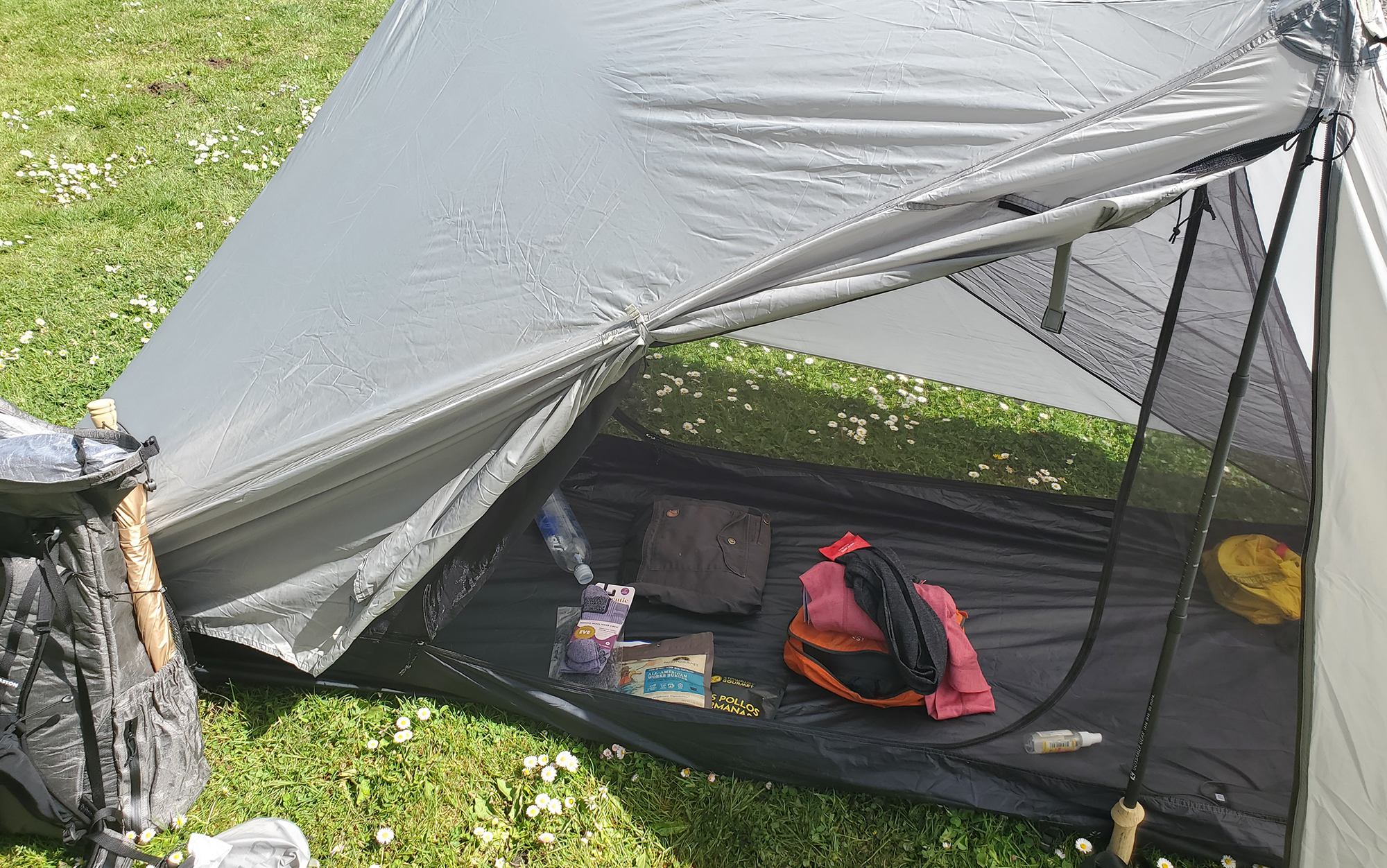
Even though the rainfly was soaked from the unrelenting condensation of the Oregon Coast, I was completely dry in this tent, thanks to its double-wall setup. What makes the Durston X-Mid 1’s double-wall design especially unique is that it was designed to be pitched fly first — no additional groundsheet required. Our testers also noticed that the pitch had steeper walls than was typical, which maximizes livability — even if it doesn’t technically give you more floor space.
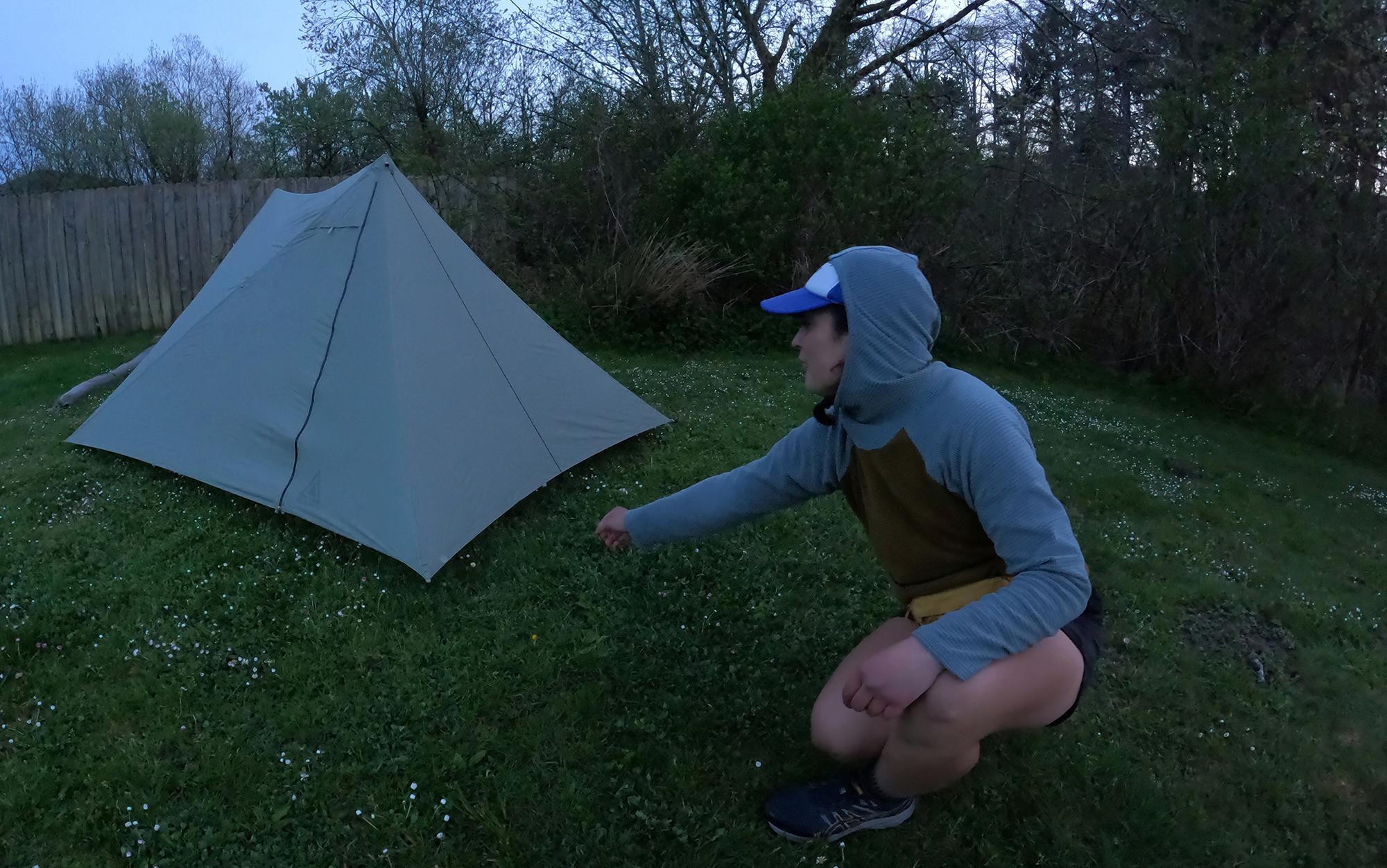
The Durston X-Mid 1 even had two doors and two vestibules, unique among one-person tents to our knowledge. Even though it’s a similar weight to the other double-wall ultralight tents we looked at, the Durston X-Mid 1 is (at the time of this review) about $200 less expensive. Hiker trash: This one is a no-brainer.
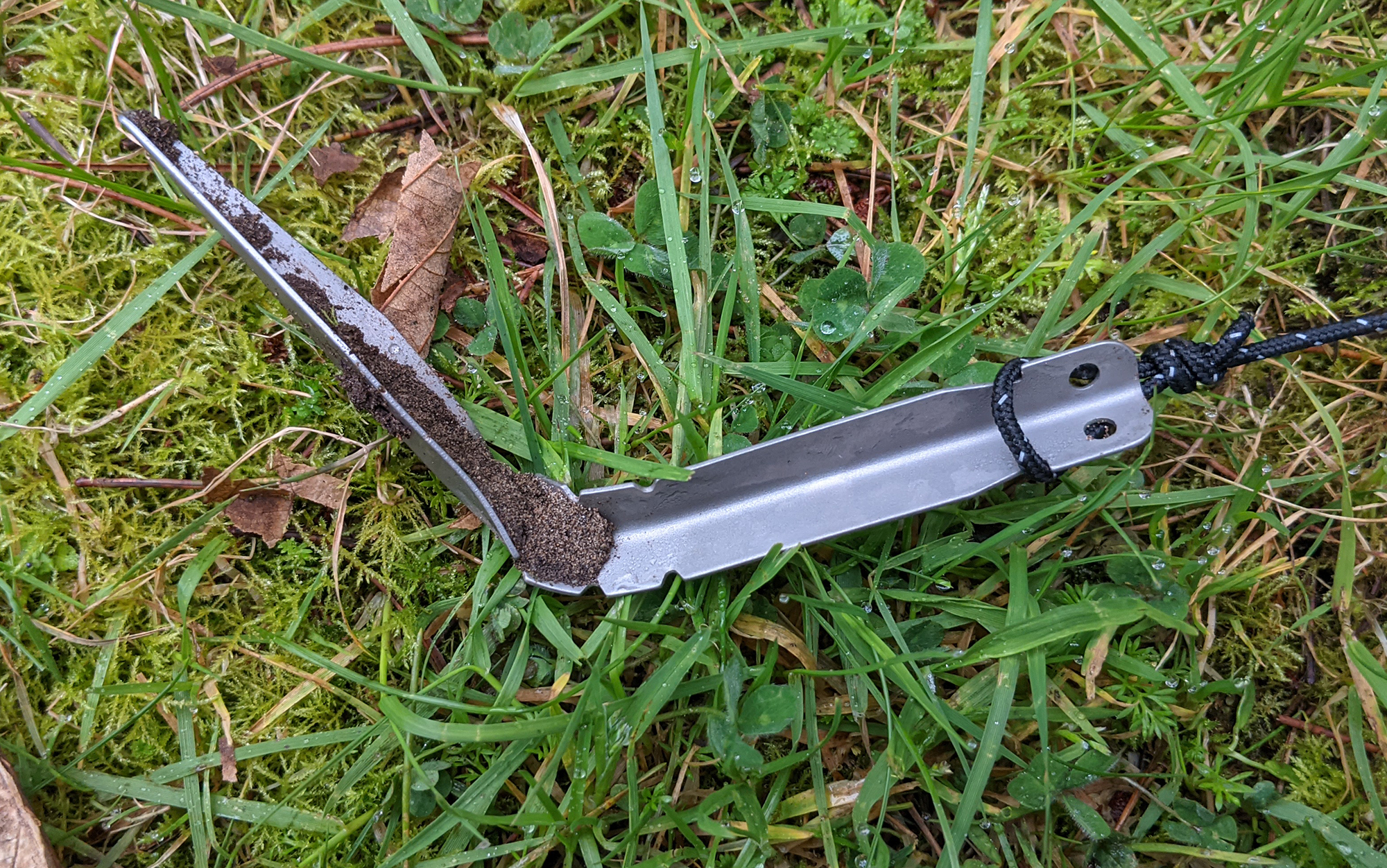
So what’s wrong with this tent? To start: It’s not your lightest option. For the same weight as the Durston X-Mid 1, you could get a fully freestanding tent. (Durston does offer a 1-pound version of this tent in DCF, but the price point for that is up there with some of the pricier ultralight tents.) Its setup also proved challenging for testers accustomed to freestanding tents. If this is your first trekking pole tent, give yourself some time and space to play around with perfecting the setup.
Read Next: Best Tent Stakes
Finally, you remember I mentioned a stake popped out the first night we used this tent? That stake had bent while being pushed into reasonably soft ground. I’d plan to replace them with one of the best tent stakes, with an eye toward MSR Groundhog minis or Big Agnes Dirt Daggers.
Read our full review, Durston X-Mid 1 Review: A Beginner-Friendly Ultralight Shelter.
Lightest: Gossamer Gear Whisper
Tested in the Goat Rocks Wilderness by Jac “Top Shelf” Mitchell, Diana Helmuth, Ashley Thess, and Laura “Chop Chop” Lancaster, with input from Patrice “Steady” La Vigne
Report Card
- Ease of Setup: 3.6
- Interior Living Space: 3
- Protection: 2.6
- Value: 2.6
- Measured Weight: 10.1 ounces (.1 ounce more than advertised)
- PFAS free
Key Features
- Max Head Height: 51 inches
- Doors: 1
- Materials: Dyneema
- Warranty: 1 year
- Price: $500
- Optional aluminum poles available (5 ounces per set)
Pros
- Ridiculously lightweight
- Surprising interior space
- Conversation starter
Cons
- No dedicated floor
- Harder setup than others on this list
- Comparative lack of privacy
The Gossamer Gear Whisper was one of the most impossible-looking tents our testing group had ever seen. At its core, this tent is something like a cross between a tarp and a single-wall trekking pole tent. It has the weight-savings of the former, but the setup is closer to the latter. Gossamer Gear co-founder Glen Van Peski designed the Whisper for a specific trip he was headed out on, and only 500 were released as an initial limited run — perhaps, at first glance, it didn’t seem like a tent with widespread appeal. But it flew off the shelves, and Gossamer Gear ended up making it a permanent part of their offerings.
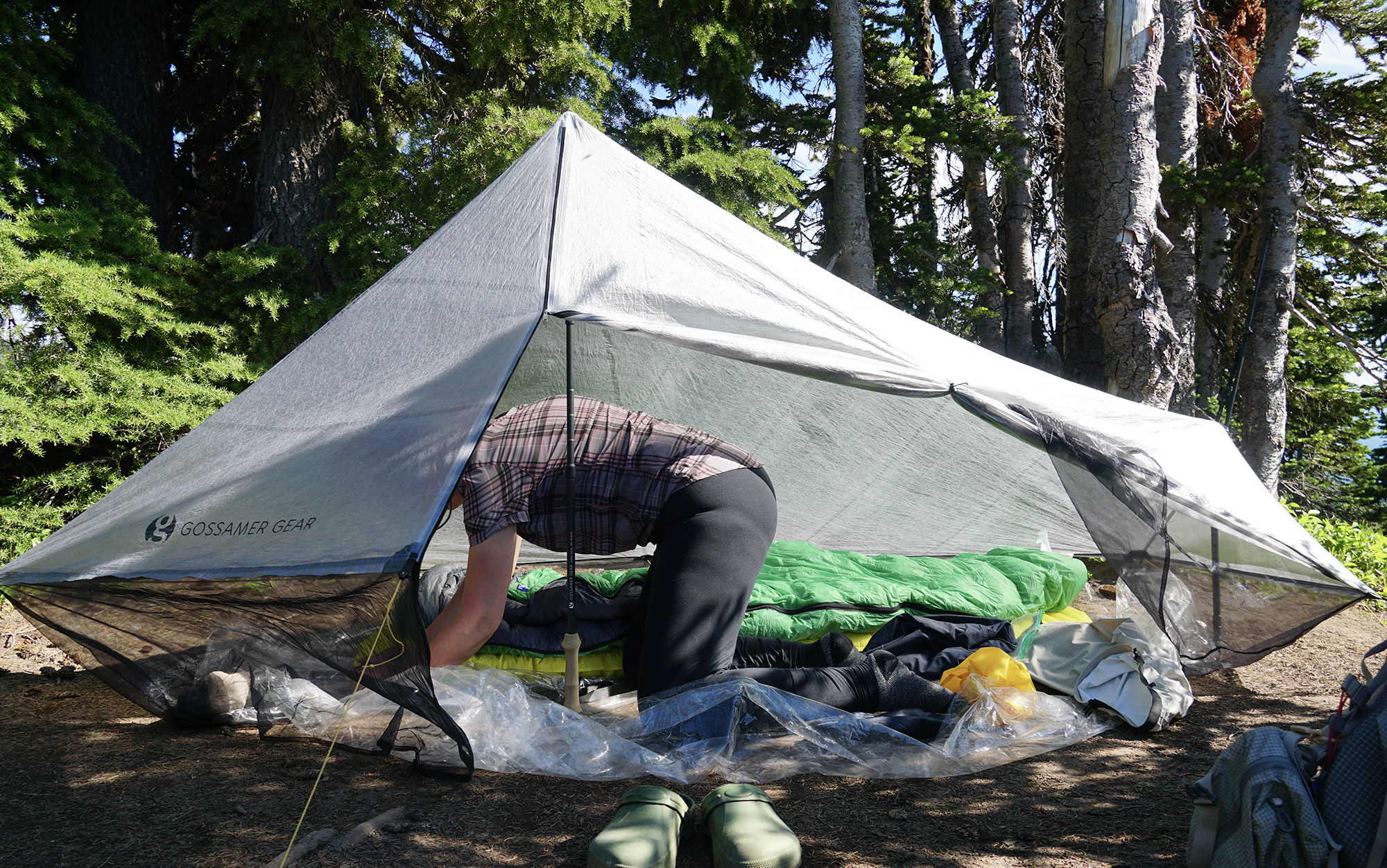
Alex Robin
After sharing this tent with our testing team, I can see why it has such appeal for a certain subset of ultralight backpackers. There have always been a couple limitations to the tarp setup. The first is that you will be the entree at the buffet for any mosquitoes around. The Whisper solves this nicely by having a mesh skirt along the bottom of the tent. The second is that, for something seemingly so simple looking, tarps are tricky and time-consuming to set up. And that is where the Gossamer Gear Whisper really shines. After I read Glen’s stream-of-consciousness directions on the Gossamer Gear site under the FAQ (which I definitely recommend), it took me less than 10 minutes to set up on my first attempt. The basic idea is to start at the foot, staking out around the shorter trekking pole, and then pull it taut as you stake each successive loop in until you get to the side with the taller trekking pole. I imagine with a bit of practice, I could get this tent up about as quickly as any other trekking pole tent.
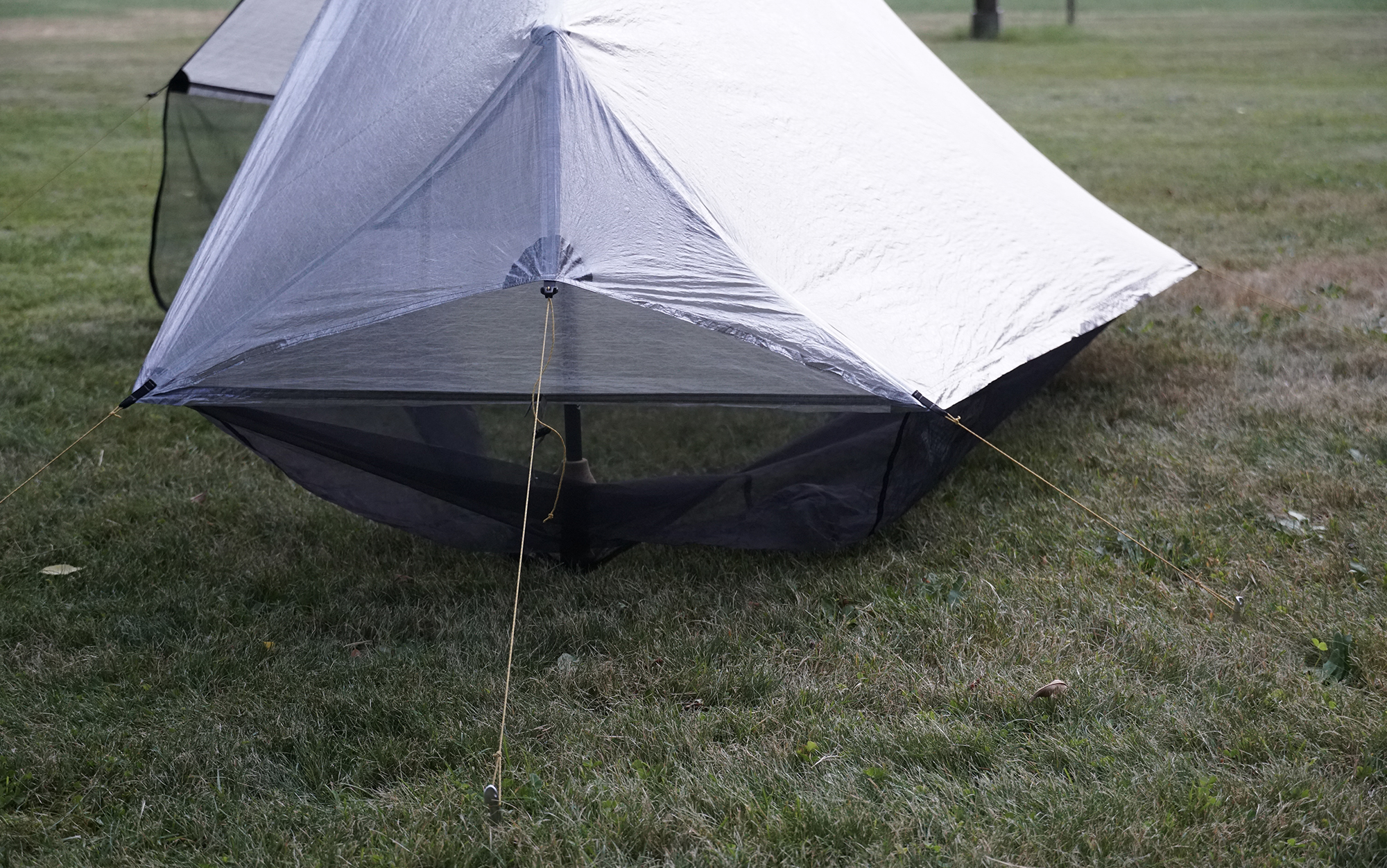
Alex Robinson
Other testers had similarly positive experiences with the setup. Experienced thru-hiker Top Shelf called it a “quick, easy, and self-explanatory,” noting that the DCF makes it easier to create a taut silhouette than you would get with silnylon. Diana and Ashley also both got the tent up without too much trouble after I provided a recap of the recommended strategy.
Testers’ feelings about actually sleeping in this tent varied dramatically. “It feels like my first tent,” said Top Shelf. “Just enough of what you need and nothing you don’t.” Ashley did not have similar warm fuzzies, stating that she wouldn’t trust this tent in any kind of weather. And Diana opted to forgo sleeping in it at all, swapping with Steady on the third night of our test. That turned out to be the windiest night, with several testers set up in more exposed locations reporting their tent structure being compromised. So it was notable that Steady, set up with some tree protection, came away impressed with the structural integrity of this tent, giving it a 4, the highest rating of our testers.
“I felt the wind blowing in through the mesh bottom part, but I wouldn’t have known it was windy (maybe 10 mph) because the rest of the tent body was as tight as a trampoline,” she said. “You could bounce a penny off it.”
When I tested this tent on the final night of our trip, I had the chance to experience this firsthand. The tent looked like it was standing up with pixie dust, which didn’t make me feel as secure inside of it as I wanted. But the actual structure was so rigid and taut that no matter how many times I knocked into the center pole, it didn’t move at all.
Gossamer Gear doesn’t opine on how many people this tent will fit, but our take is that, while it just barely fit our two gal testers, it’s really a roomy fit for one. While there is technically space on both sides of the center pole for two sleeping pads, the logistics of cramming in any extra gear or, heaven forbid, the person on the far side needing to use the restroom in the middle of the night, makes this a no-go.
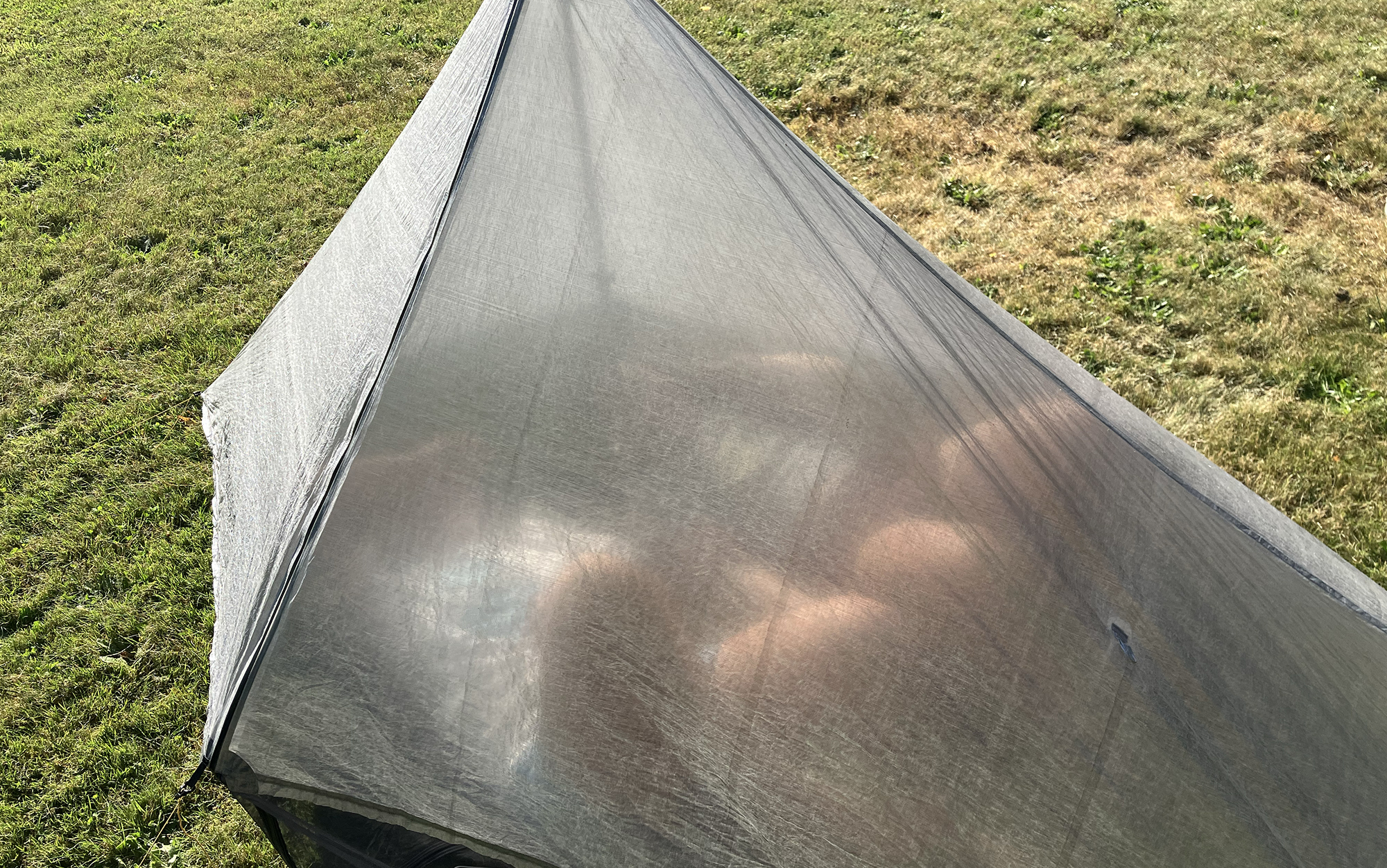
Diana Helmut
More than any other tent on this list, trust your gut on this one. If you’re an old hand at trekking pole tents or tarp-curious, this could be just what you need to really drive that base weight down. But if the idea of forgoing a floor and having the bottom four inches of your tent be nothing but mesh gives you pause, then go with another pick on this list.
Best for Tall People: Tarptent ProTrail
Report Card
- Ease of Setup: 2
- Interior Living Space: 2.5
- Protection: 3
- Value: 4
- Measured Weight: 1 pound, 8.2 ounces (.2 ounces heavier than advertised)
- PFAS free
Key Features
- Max Head Height: 45 inches
- Doors: 1
- Materials: Ripstop nylon floor; ripstop polyester shell
- Warranty: Limited lifetime
- Price: $240
- Optional carbon fiber poles available (6.9 ounces per set)
Pros
- Usable length makes this a great option for taller individuals
- Could fit two people in a pinch
- Affordable
Cons
- Tends to sag in the middle in condensation-prone conditions
- Individuals with a shorter wingspan will struggle with setup
Plenty of people over 6 feet tall won’t even look at a one-person ultralight tent. After all, the easiest way for manufacturers to save weight and protect your UL bonafides is to simply make your tent smaller than the competition. And, to be honest, our all-women testing crew, which topped out at 5 foot 10, was mostly fine with that. But there was one ultralight tent we tried that was clearly built with an over six-foot individual in mind: the Tarptent ProtTrail.
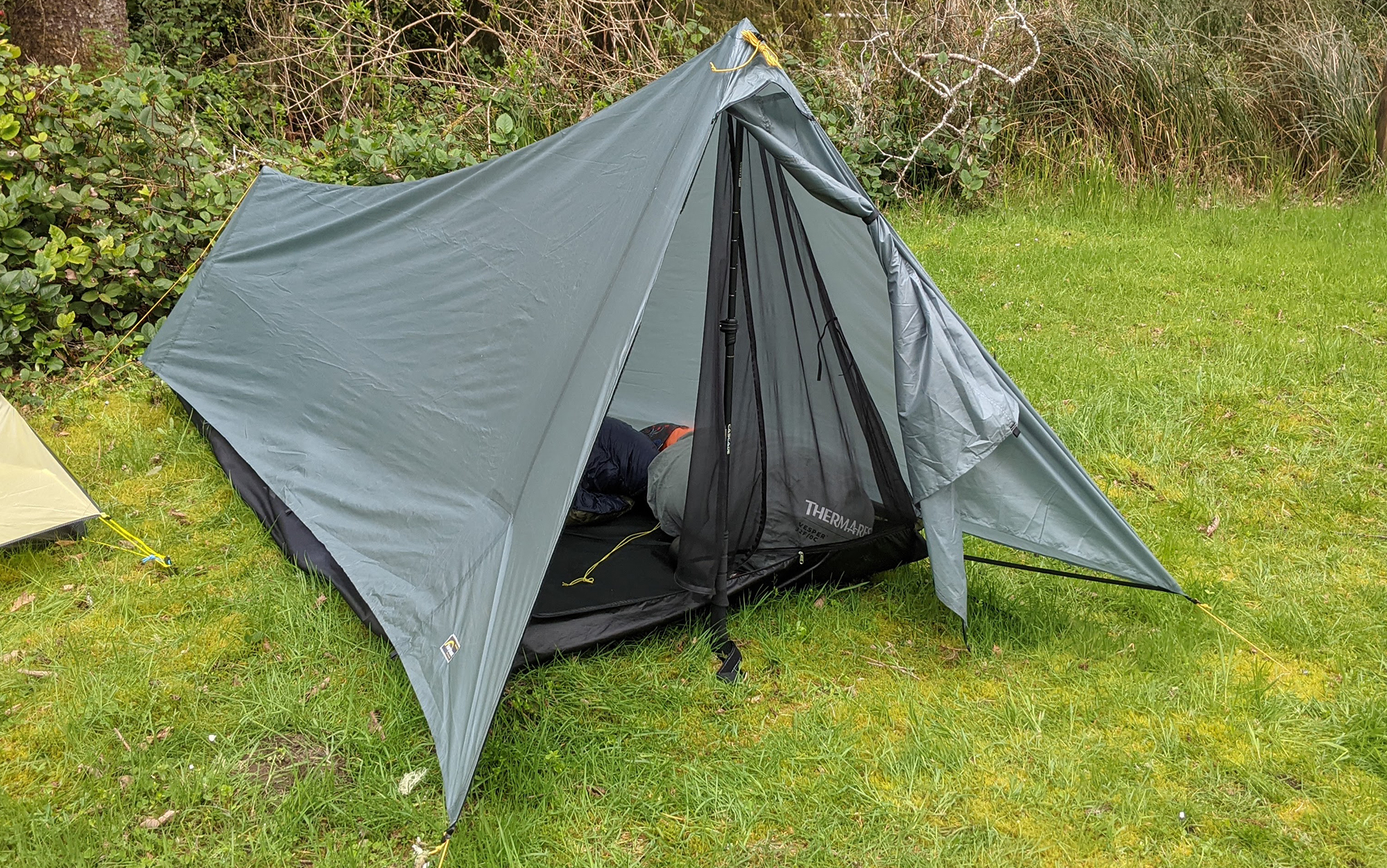
While plenty of other ultralight tents claim a similar 84-inch length, few actually have that much usable space, due to the taper of the walls. Not so in the Tarptent ProTrail, which has fully vertical sides at the top and the bottom of the tent. We think that anyone up to six foot four would be comfortable lying down inside this tent.
Unfortunately, getting in is a different story. The Tarptent Protrail has head-in entry, which most testers found to be somewhat uncomfortable and awkward to use, especially when they were tired after a long day of hiking.
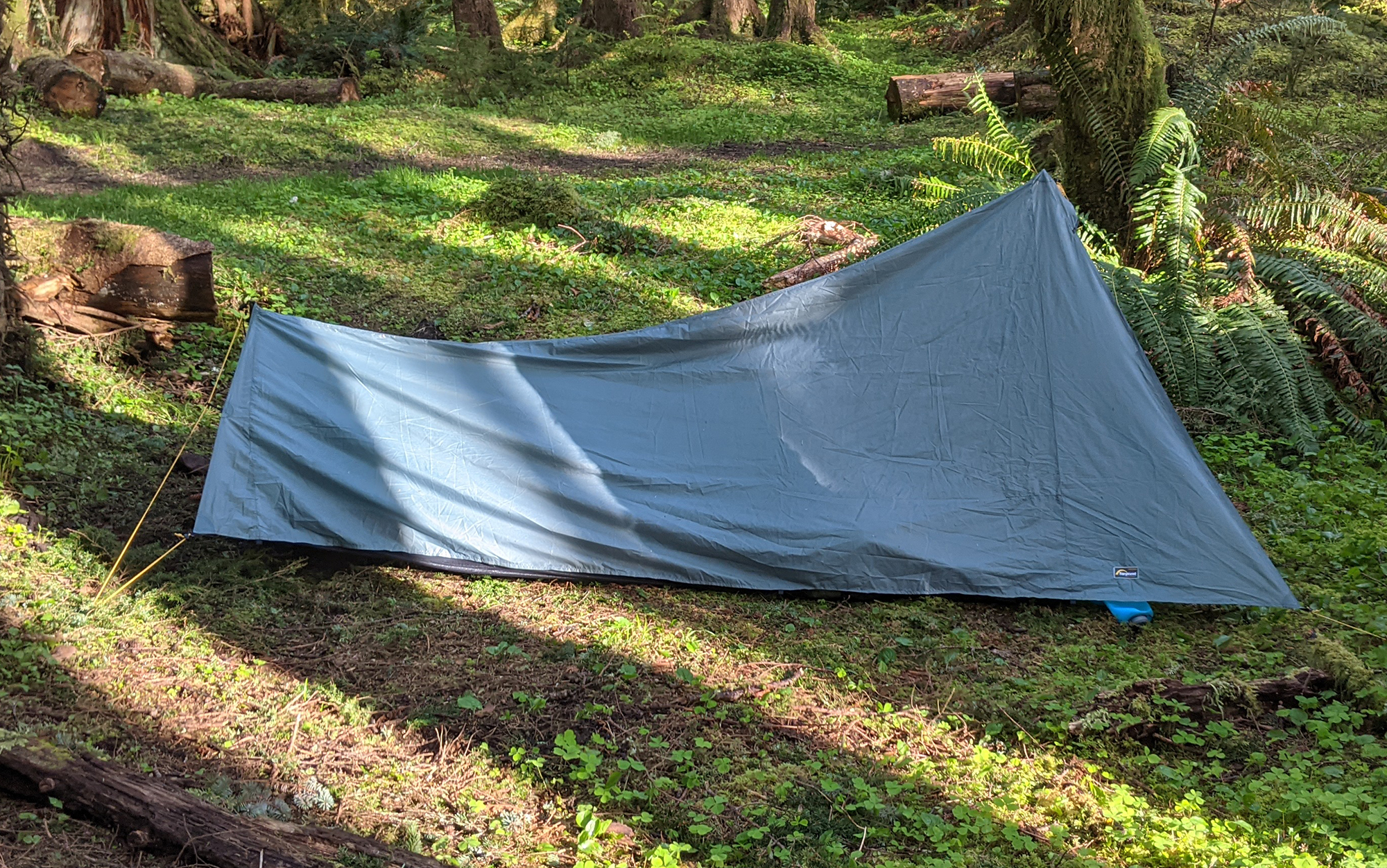
The two trekking poles used in the setup of the Tarptent ProTrail were separated lengthwise, 84 inches from one another. That long profile, without any additional support or structure in the center, meant that it sagged more from the condensation than anything else we looked at. We would also have concerns about this tent in serious wind conditions if it was angled incorrectly or if wind was coming from multiple directions.
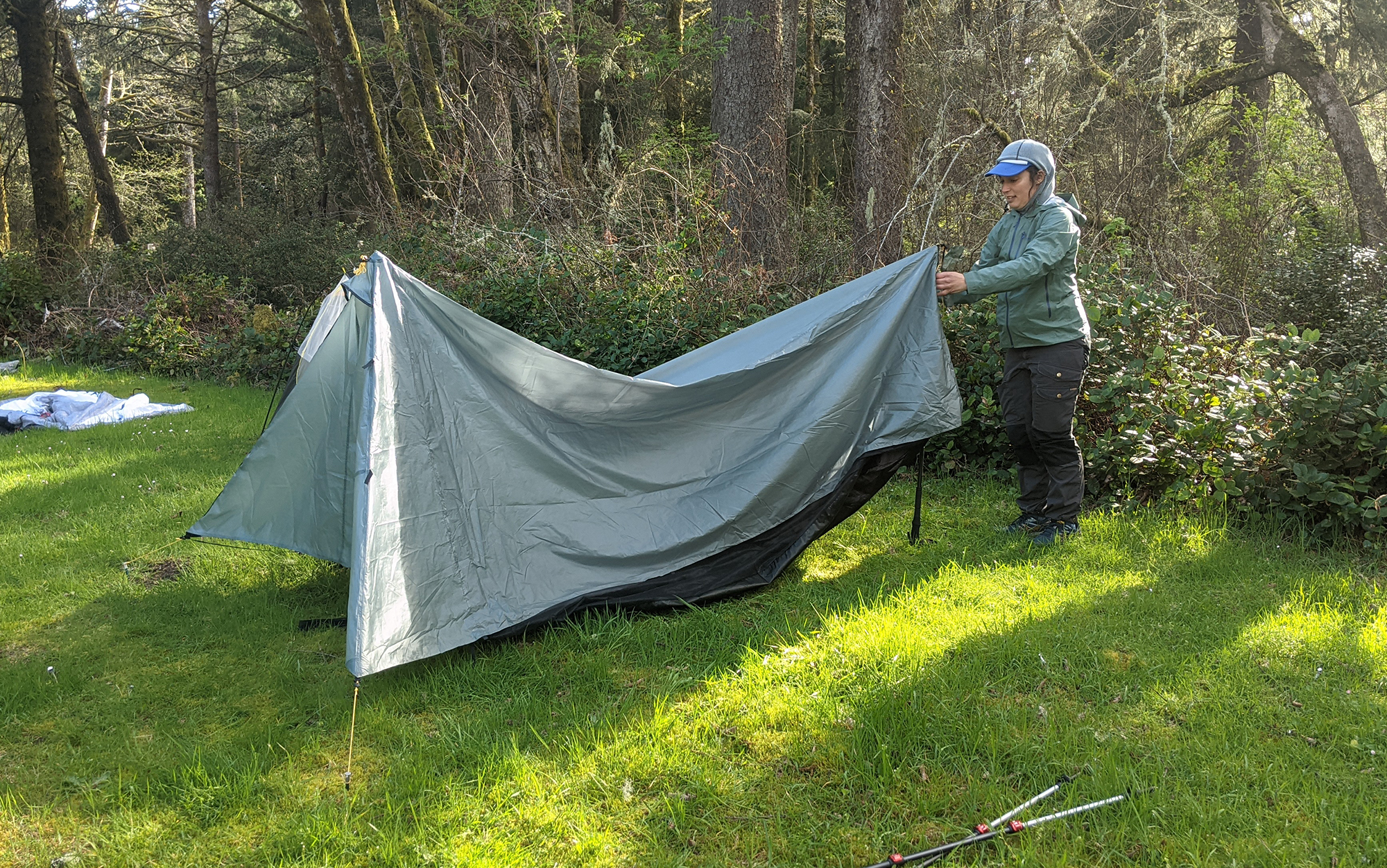
It’s worth noting that shorter people will struggle to set up this tent, as one of our testers discovered on the final night of our trip along the Oregon Coast Trail. That’s because the front trekking pole must be held upright at the same time as you stake out the far door: the wingspan of a shorter individual just can’t reach that far.
Zpacks Plex Solo
Report Card
- Ease of Setup: 2
- Interior Living Space: 2
- Protection: 3
- Value: 3
- Measured Weight of the 1-Person Model: 15.9 ounces (weight includes stakes; not included in purchase price or advertised weight)
- PFAS free
Key Features
- Max Head Height: 52 inches
- Doors: 1
- Materials: Dyneema
- Warranty: 2 years
- Price: $600
- Optional carbon fiber pole available (2.8 ounce)
Pros
- By far the lightest tent in our test
- Single pole set up
Cons
- Expensive
- Experience needed to achieve the correct pitch
- Requires a taller trekking pole to pitch properly
Our testers had more mixed feelings about the Zpacks Plex Solo than anything else we looked at. The weight of this tent impressive; it’s also twice the price of our best overall pick in the trekking-pole category. The Dyneema shell that helps give this tent its low weight was also surprisingly cozy, with our tester noting that it was easily 5 degrees warmer inside than out. Nonetheless, if the pitch wasn’t just so, it felt, in the words of one tester, like “sleeping inside of a wet trash bag.”
The incorrect pitch was not for lack of trying. Our tester, who described the provided instructions as some of the best we looked at, spent a long time trying to get this one right. But then she’d get into the tent and realize something wasn’t quite right with one or more of the ten stakes. After getting out to adjust the stakes and the guylines, she’d get in again, and see that now something new was wrong. By morning, she was pretty frustrated, but other members of the testing trip who had used Zpacks before simply nodded sagely. The pitch on these tents is tough to master.
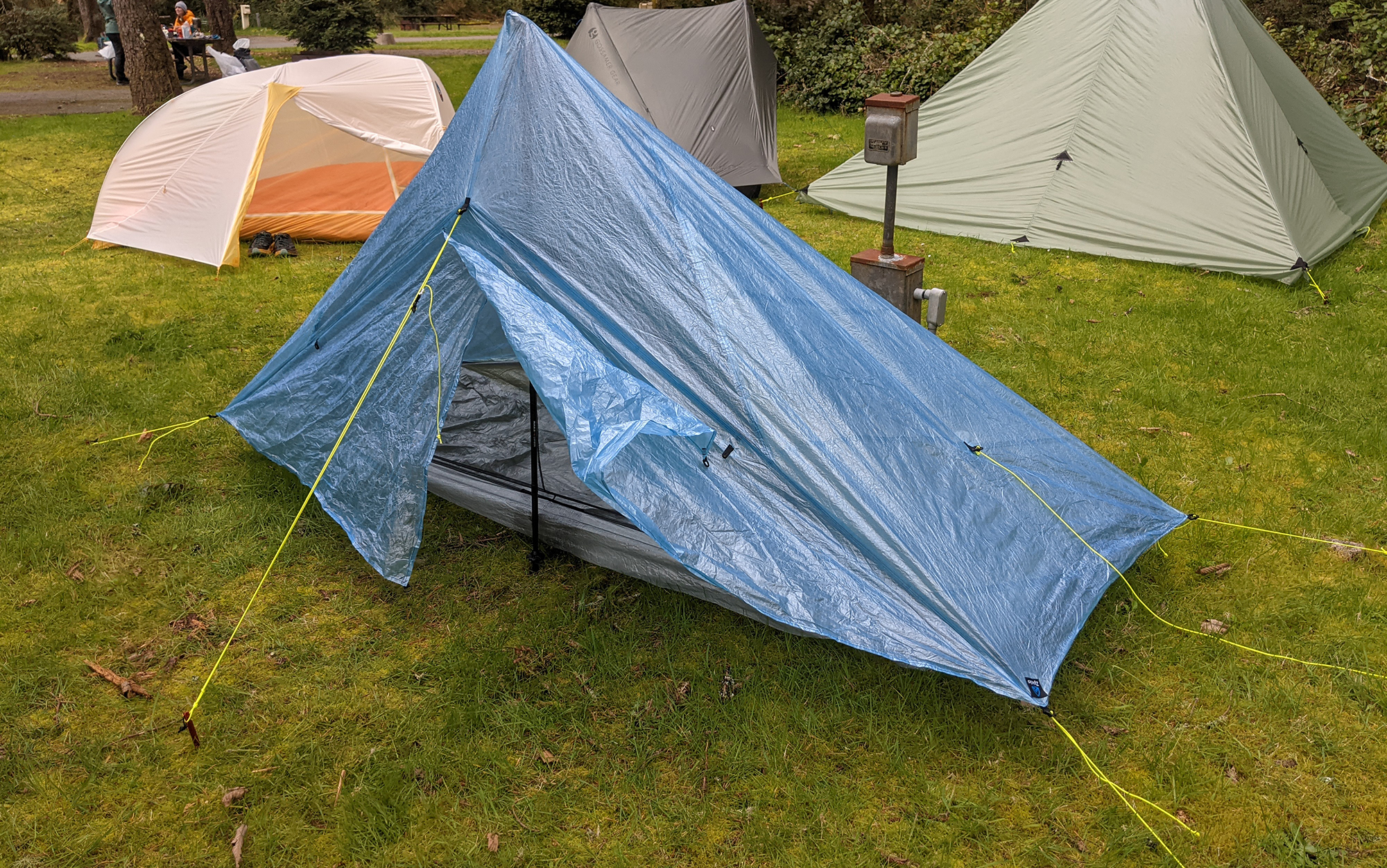
We also had concerns about its storm-readiness. Unlike other ultralight tents, there is no zipper on the door, just clips at the corners of the two sides that secure to a stake. That means rain and wind can both push their way through if you haven’t protected yourself by some other means. Experienced thru-hikers will know if this is a risk they are willing to take. After all, some trails are unlikely to see conditions that would make this an issue, and there is always the option to prop your backpack up in the door to provide some extra protection. But we think early-career ultralight backpackers should think twice before committing to a setup like this.
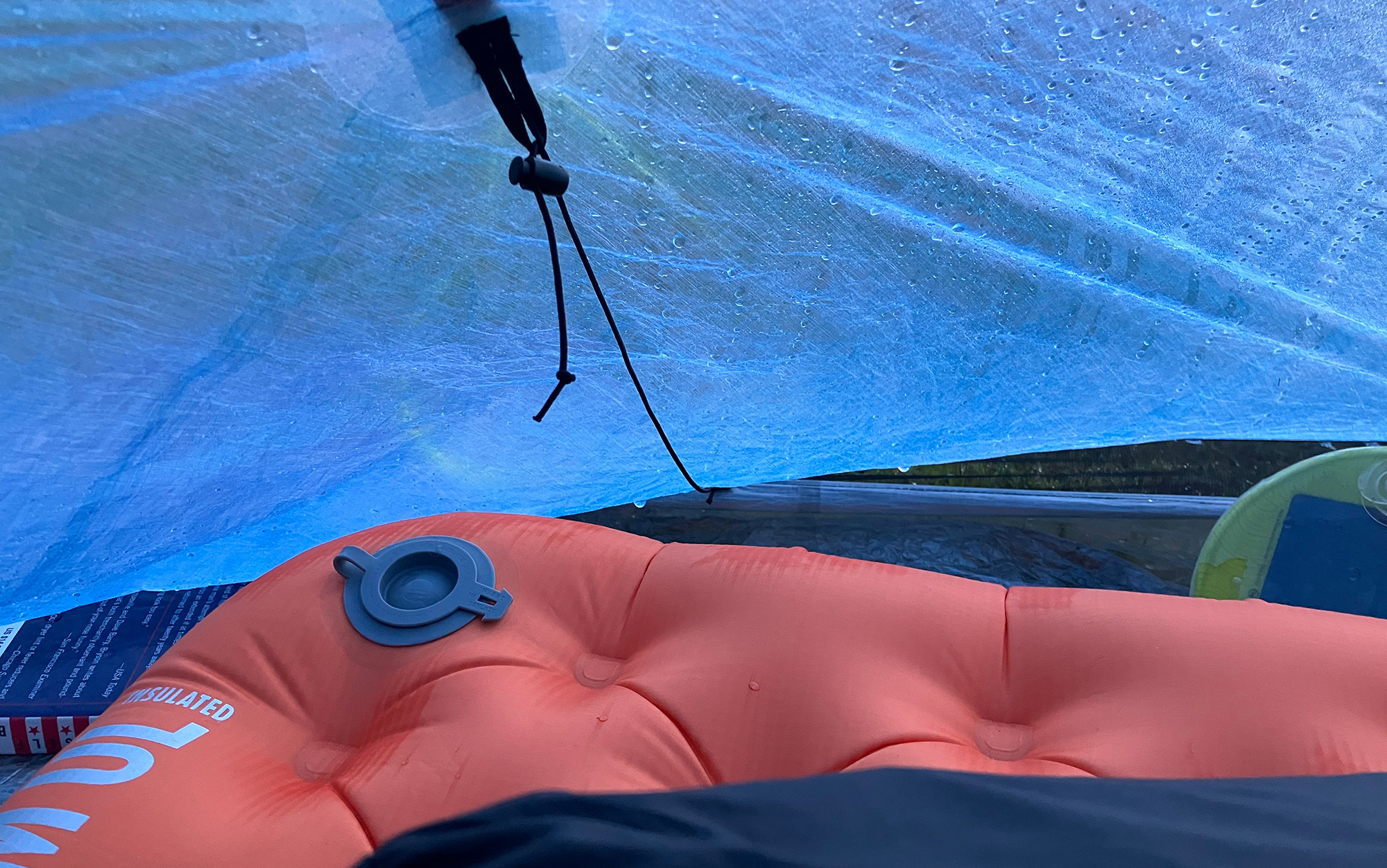
If you’re new to ultralight tents, especially if you’re new to trekking pole tents, we think you should shelve this one for the time being and opt for a slightly heavier model like the Gossamer Gear THE ONE or Durston X-Mid-1. But if you’ve been using ultralight tents for some time, and are ready to upgrade to that elusive sub-10 pound kit, then this should absolutely be on your short list.
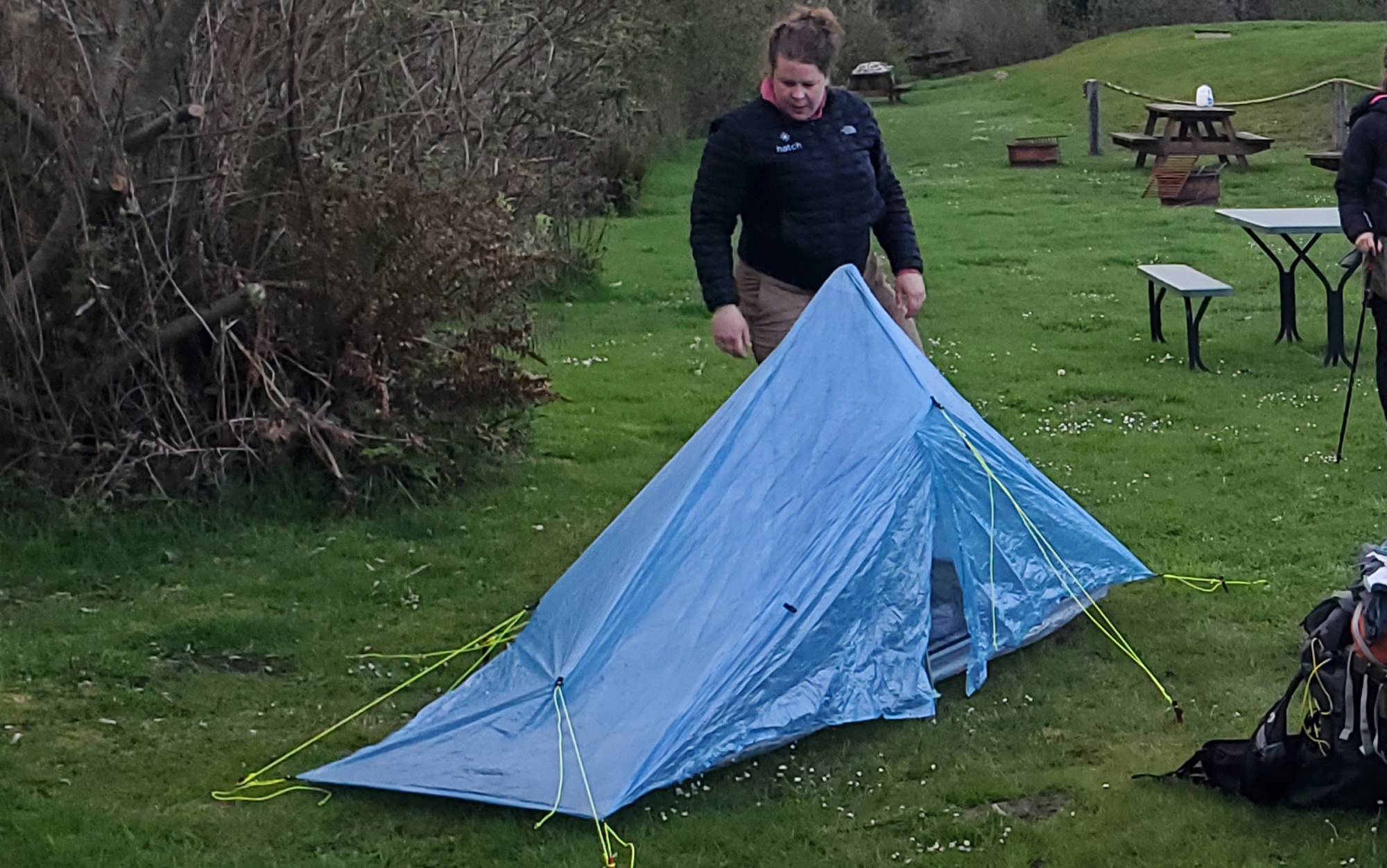
Like the Six Moons Lunar Solo, this one doesn’t come with stakes — you’ll need to buy those separately. While our first recommendation is for the MSR Groundhog Minis, that’s going to push you up over the one pound mark. To keep this under a pound in total weight (and get all ten stakes — you’ll need them to take full advantage of the interior space), go for the MSR Carbon Core.
The last note is to check your current trekking poles. The best pitch is achieved with a pole set to 132 cm in length, but some poles don’t extend that far.
Seek Outside Sunlight
Tested in the Goat Rocks Wilderness by Alex Robinson, Adam Tycaster, Jac “Top Shelf” Mitchell, Laura “Chop Chop” Lancaster, and Diana Helmuth
Report Card
- Ease of Setup: 4
- Interior Living Space: 4.8
- Protection: 4.3
- Value: 3.8
- Measured Weight: 2 pounds, 10.1 ounces (3.1 ounces heavier than advertised)
- PFAS free
Key Features
- Max Head Height: 50 inches (2P)
- Doors: Two doors (2P)
- Materials: Ripstop nylon
- Warranty: Limited lifetime (also provides repair for a fee)
- Price: $450 (2P)
- Optional carbon fiber poles available (8.4 ounces for a set)
Pros
- Spacious
- Quality materials
- Easy setup (for a trekking pole tent)
- Made in the USA
Cons
- Expensive
- Heavy for an ultralight tent
- The optional carbon fiber poles were heavy (8.4 ounces) and confused testers
The Seek Outside Sunlight was the only non-freestanding tent that was set up in the exposed alpine area on our third night of testing in the Goat Rocks Wilderness (the other three trekking-pole tents were set up among the trees). The tester, Top Shelf, reported that it stayed up fine, although there were some hiccups along the way given the less than ideal staking-out situation. “It felt homey, spacious, and super storm-worthy,” she noted. Robinson, who tested it on the final night when we were camped in muggy conditions near a pond, reported no condensation.
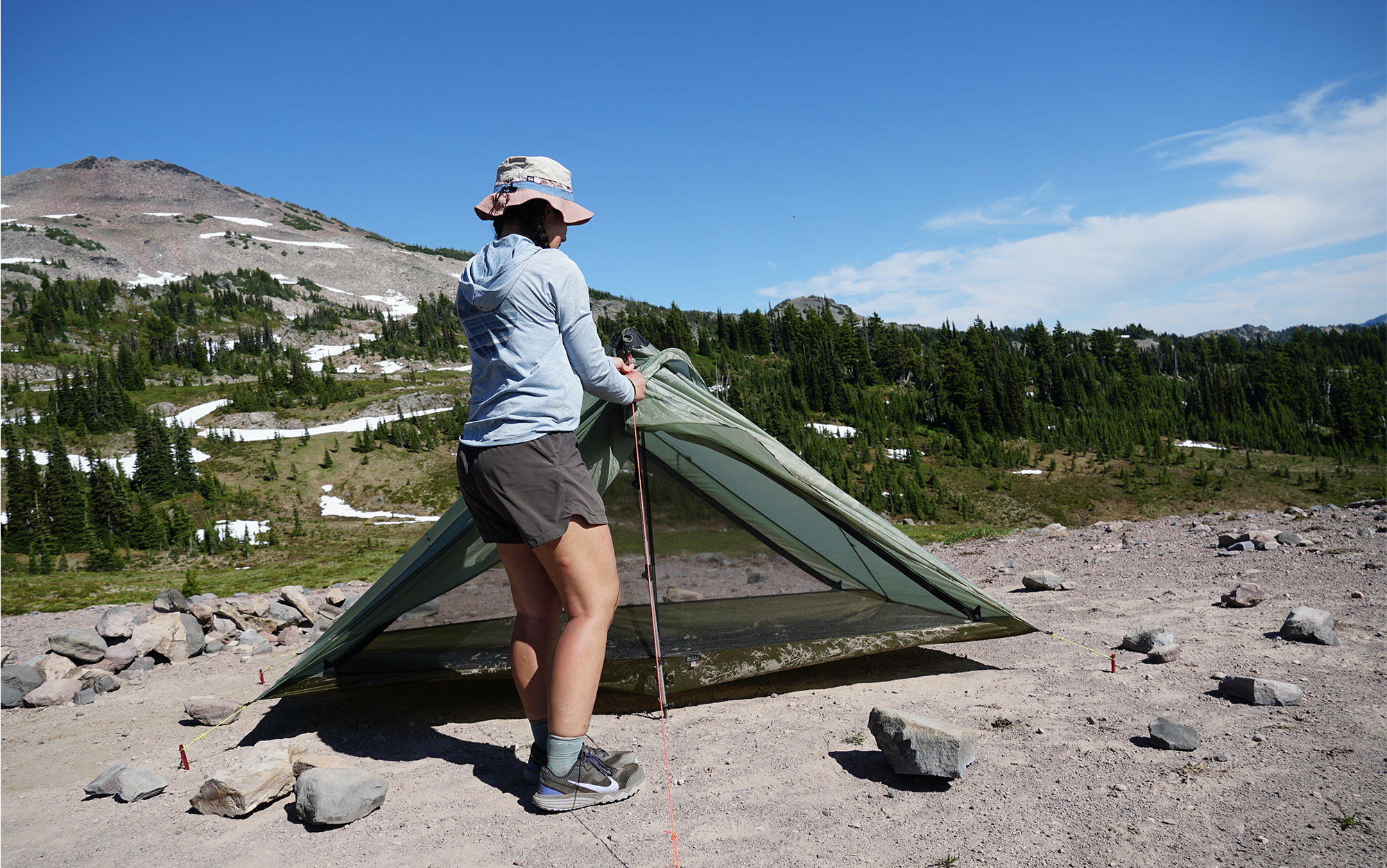
Alex Robinson
All the testers for this tent were effusive in their praise. “Easiest trekking pole tent to set up I have ever experienced,” said Helmuth. While the Seek Outside Sunlight is noticeably more expensive than the Gossamer Gear The Two, which has a similar silhouette, there are several reasons to choose this version. First off, this tent has incredible interior space, by far the most of any two-person tent we looked at. Two large and tall individuals will easily fit inside this tent without feeling overcrowded. It’s also made from 30D nylon, which should have a longer lifespan than the Gossamer Gear’s 10D. I also appreciated a unique feature, where a sliding toggle on the middle edge of each vestibule allowed you to easily access the zipped mesh door. “So simple and fun,” noted Helmuth. “Why aren’t all tents like this?”
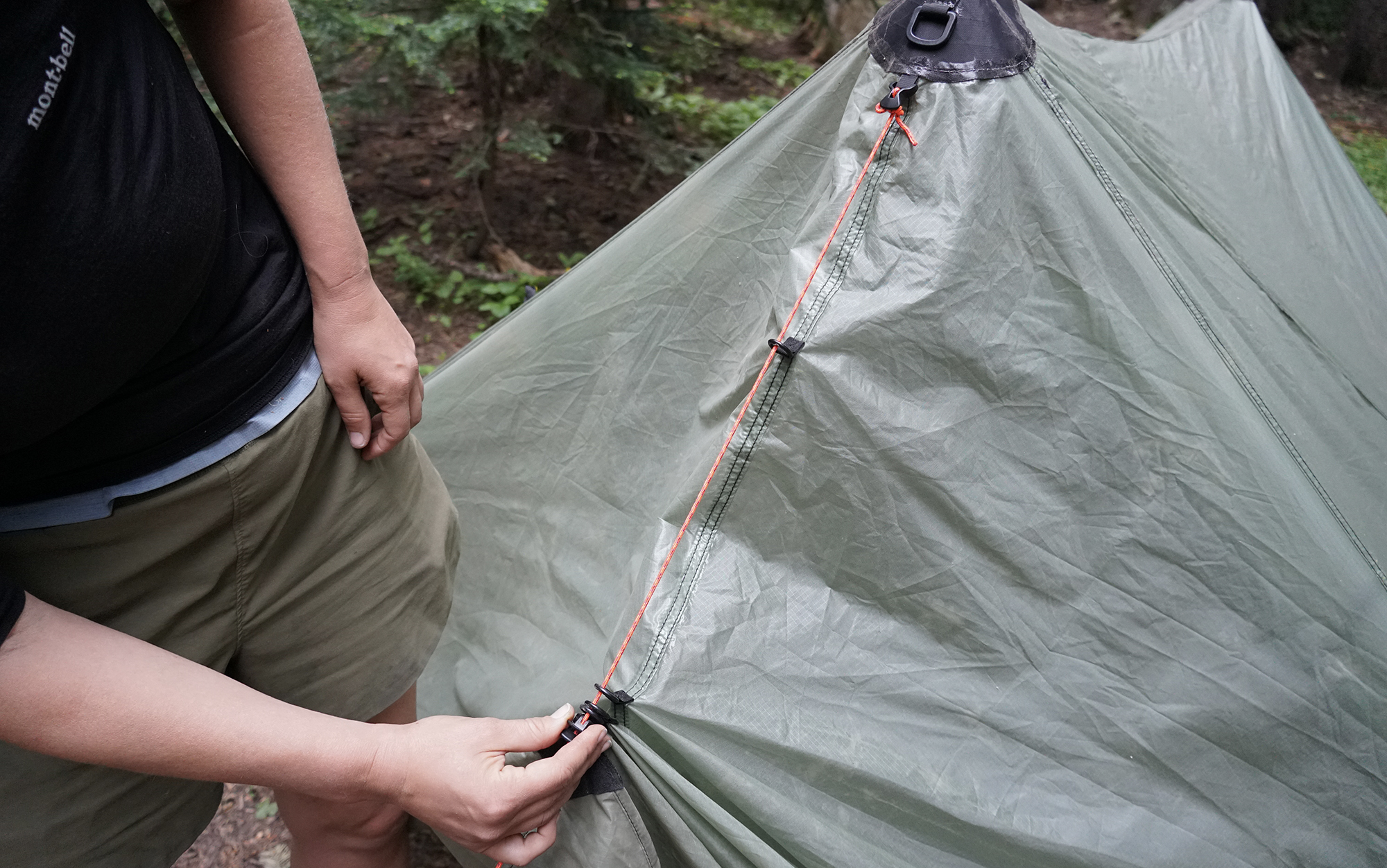
Alex Robinson
One aspect of this tent that stymied our testers was the optional carbon fiber poles, which are sold as an additional add-on. These came in four separate sections, with no color coding or other indicators to show you how best to assemble them. Almost everyone eventually figured it out, but the consensus was that trekking poles were much easier to use. While the Seek Outside Sunlight is on the heavy side for an ultralight tent, we think it’s well worth your consideration if you’ve been considering upgrading to a 3-person tent to get more interior space.
Six Moons Lunar
One-person model tested on the Oregon Coast Trail by Laura “Chop Chop” Lancaster
Report Card
- Ease of Setup: 4
- Interior Living Space: 3
- Protection: 4
- Value: 4
- Measured Weight of the One-Person Model: 1 pound, 12.9 ounces (weight includes stakes; not included in purchase price or advertised weight)
- PFAS free in 2025
Key Features
- Max Head Height: 49 inches (1P)
- Doors: One door (1P)
- Materials: Polyester
- Warranty: Limited lifetime
- Price: $260 (1P)
- Optional carbon fiber or aluminum pole available (1.8 ounces or 3.2 ounces)
Pros
- Easy to set up
- Ability to adjust the door guyline from inside the tent
- Affordable
- One person model needs only one trekking pole
Cons
- Low walls can be claustrophobic
Maybe you’re like me: You don’t typically use trekking poles while hiking, but you’ve been known to toss one into your pack for gnarly river crossings or for extra stability on steep, snowy terrain. But there’s no way you’d carry two just to use in a trekking pole setup — at that point you might as well just use a freestanding model.
The Six Moons Lunar Solo was one of the few ultralight tents in our test that used one trekking pole in its design rather than two. The result was a modified teepee structure that was surprisingly intuitive to set up. Despite having never used this tent, I was able to put it up in only a couple of minutes with no directions.
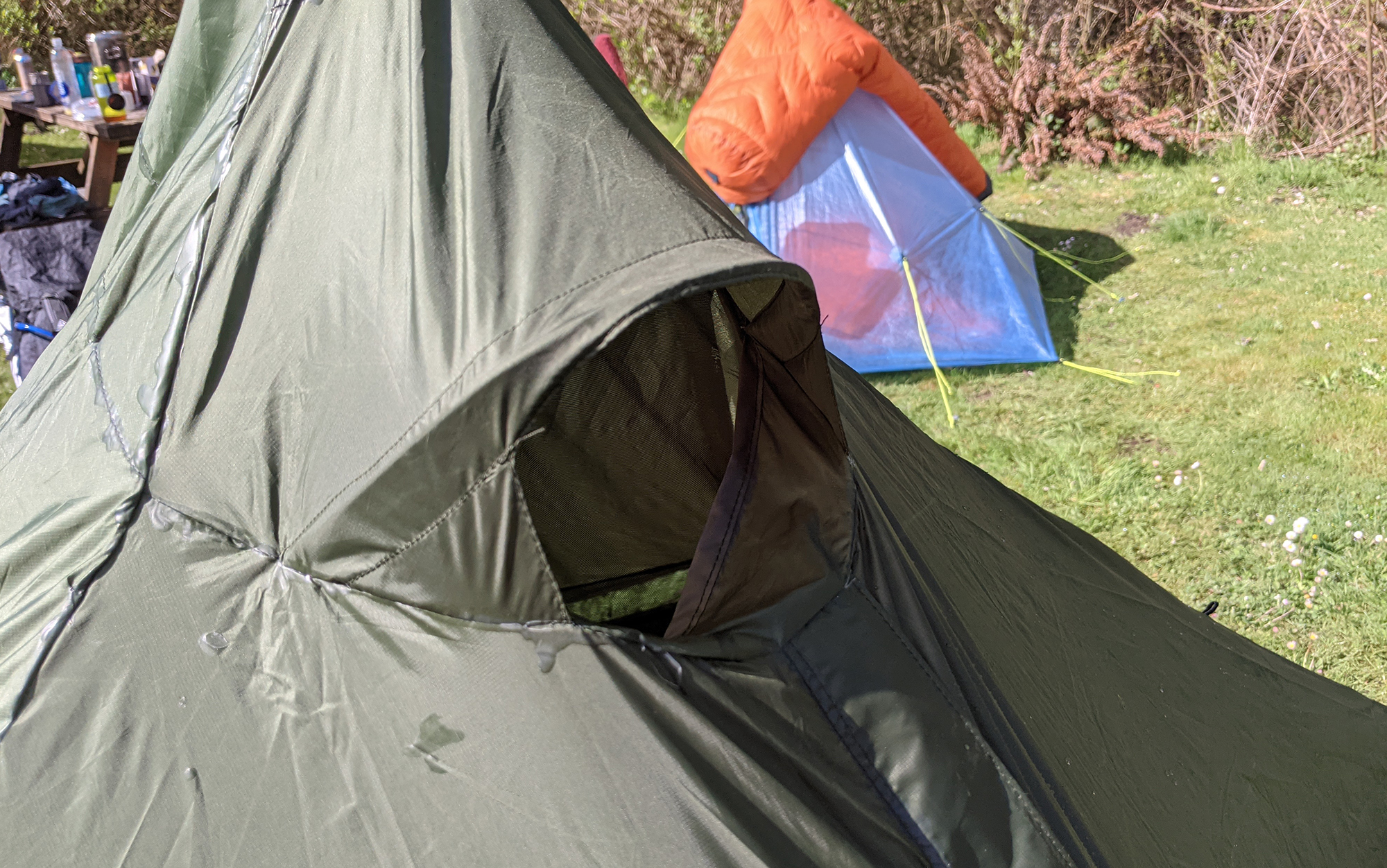
It also had a few details I appreciated. The first was a vent on the top of the tent. It didn’t help with the unrelenting fog of the Oregon Coast, but in drier climes it would reduce condensation buildup from exhaling inside your tent. It also had a tension adjustment for the rainfly door inside the tent, a thoughtful detail that I hadn’t seen before. This would allow you to get rid of excess slack (typically caused by wind or condensation) in the part of the tent covering your gear without having to get out of your tent.
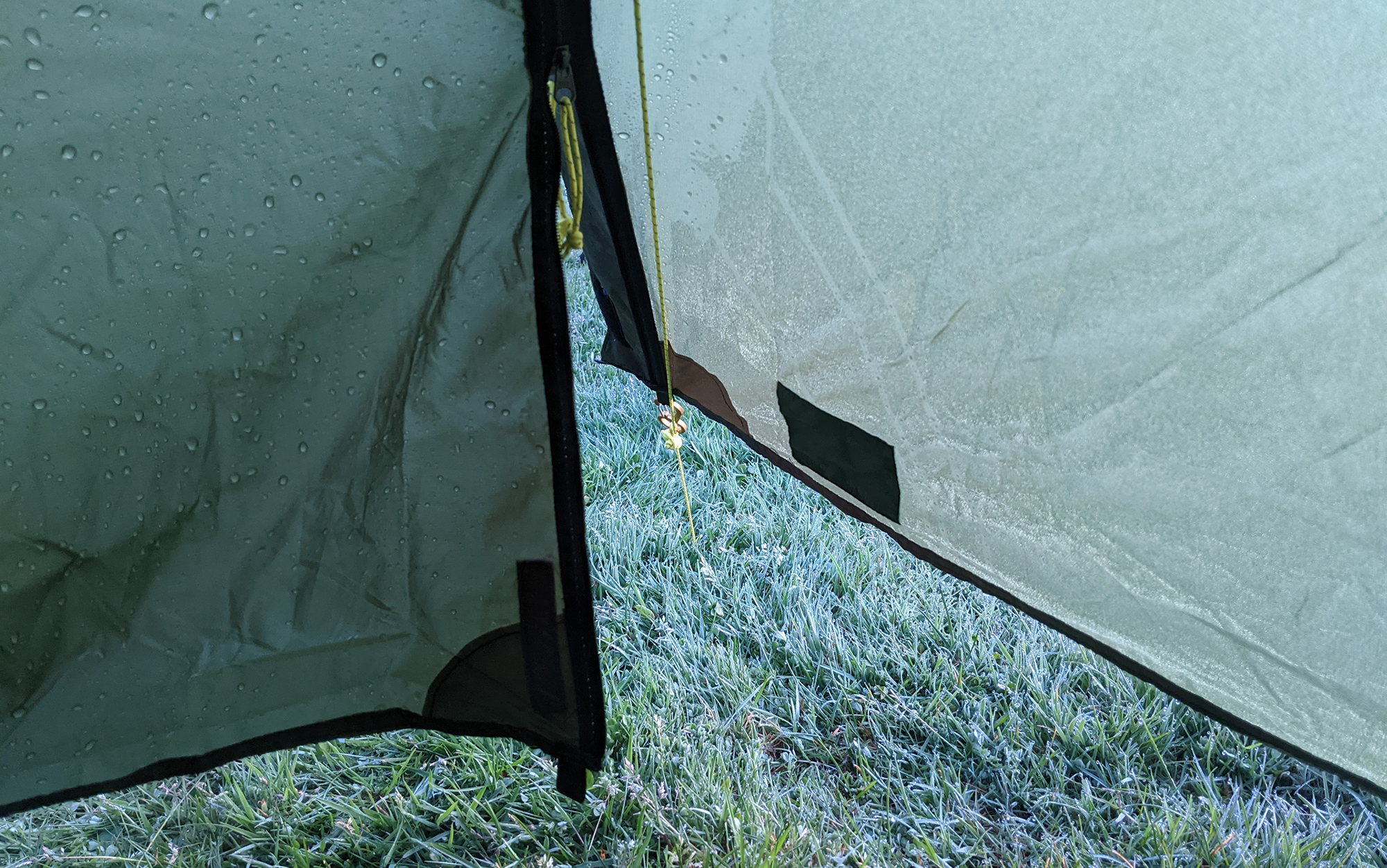
While the peak height of this tent is sufficient, I found it difficult to avoid bumping my head against the condensation-soaked tent walls in the morning. This was in part due to my site location: I was pitched on slightly uneven ground, which made it difficult to achieve the steeply sloped walls that would have been possible on flat ground.
While this tent is affordably priced, note that the price does not include stakes; you’ll need to purchase those separately.
Six Moon Designs Haven
Tested in the Goat Rocks Wilderness by Patrice “Steady” La Vigne, Sven “Magic” Anderson, Laura “Chop Chop” Lancaster, and Diana Helmuth
Report Card
- Ease of Setup: 1.8
- Interior Living Space: 4
- Protection: 3.8
- Value: 4.3
- Measured Weight: 2 pound, 10.5 ounces (weight includes stakes; not included in purchase price or advertised weight)
- PFAS free in 2025
Key Features
- Max Head Height: 45 inches
- Doors: Two doors
- Materials: Silnylon
- Warranty: Limited lifetime
- Price: $375 (2P)
- Optional carbon fiber or aluminum poles available (3.6 ounces of 6 ounces)
Pros
- Versatile setup
- Easy to split the weight between two people
Cons
- Time-consuming initial setup
- A larger stuff stuff sack is needed to simplify subsequent setups
The Six Moon Designs Haven has a somewhat unique setup that maximizes versatility while keeping the weight down. Like with the Durston X-Mid, you pitch the rainfly first, and then hang the shelter beneath it. There are a few advantages to this design. In bad weather, it makes it a bit easier to keep the inside of the tent dry when taking down the tent. (And, unlike single-wall tents, it fares a bit better against condensation.) It also means that if you don’t expect to encounter significant bugs, you can simply leave the tent body home and choose to sleep under the tarp alone.
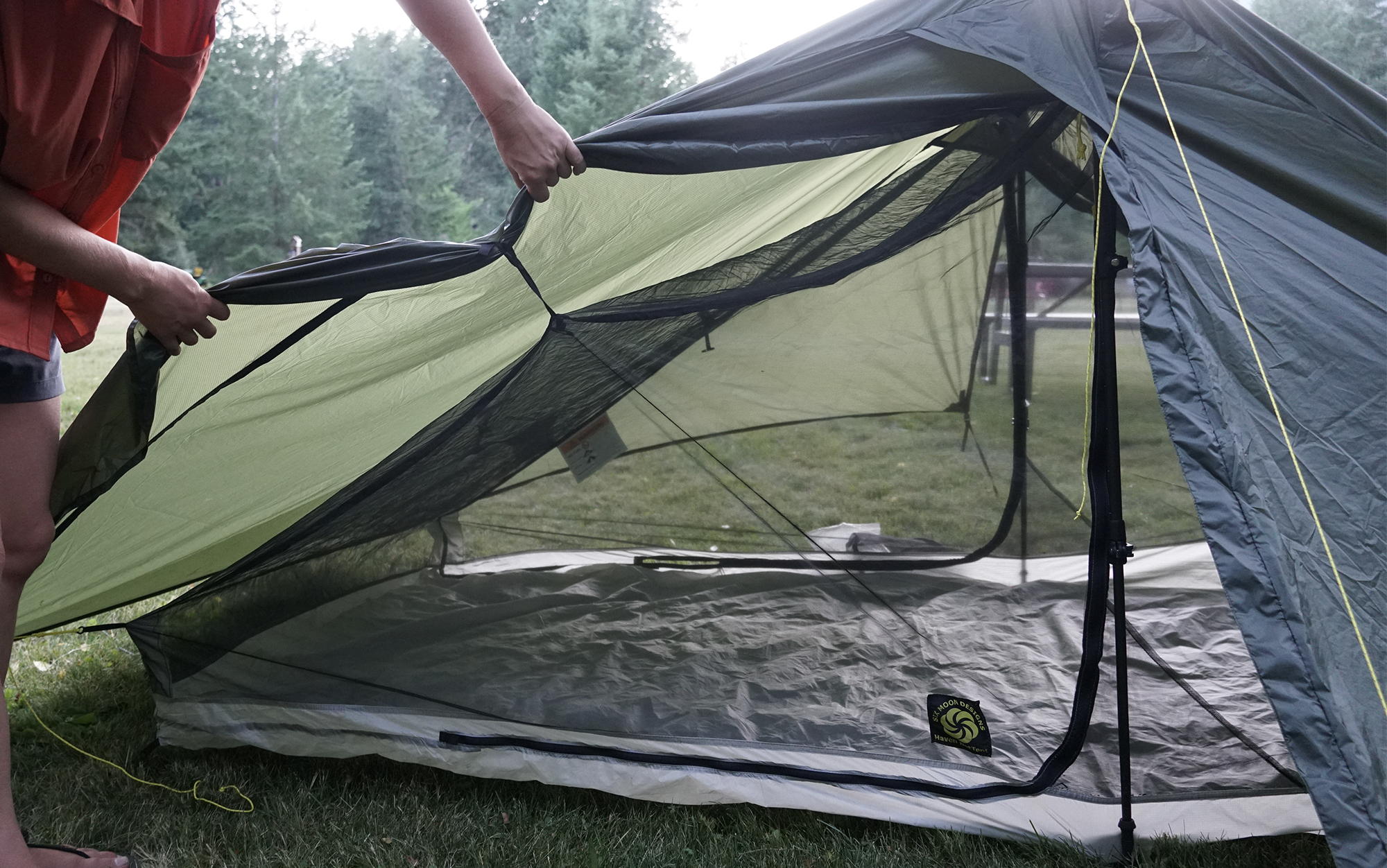
Alex Robinson
In practice, clipping the mesh tent body underneath the rainfly is a bit of a pain. “I’ve always hated the whole ‘set up the rainfly first’ because then you have to yoga pose under the rainfly to connect it to the tent body,” noted Steady, our first tester. Magic, who is hiking with Parkinson’s, also noted that “the setup is very difficult,” ranking it a 2, his lowest score during our testing trip. Other testers expressed similar frustration, especially with correctly orienting the bug net to the rainfly body, which, at least in our version of the tent, was not color coded. Some of this might have been minimized tester to tester by simply leaving the bug net attached; however, because the bug net and the rain fly each have their own dedicated stuff sack, there wasn’t an easy way to pack them away together. I would recommend that anyone looking at this tent also purchase a larger stuff sack to simplify setup in those situations where you want to leave the two halves connected.
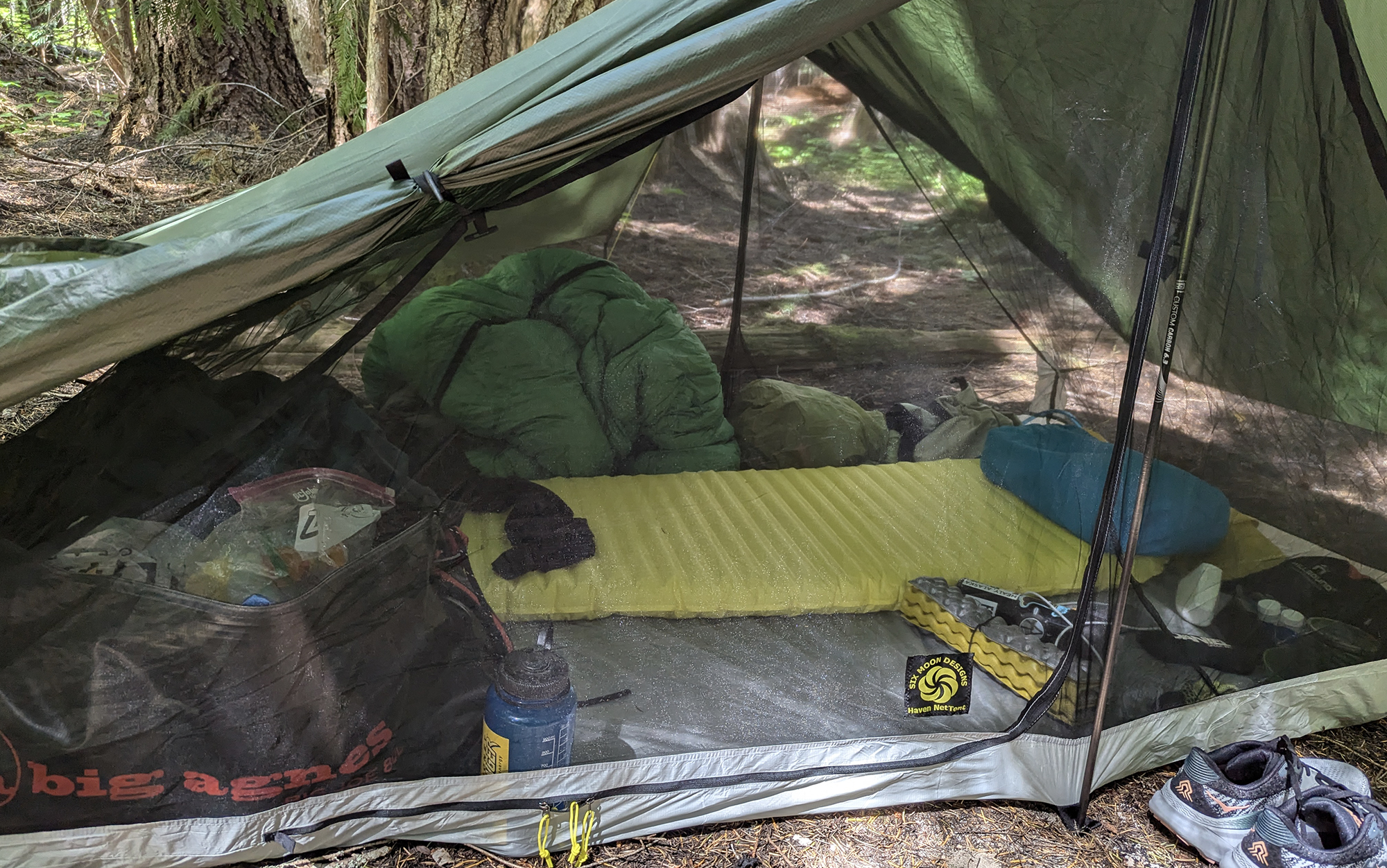
Adam Tycaster
All testers noted that the inside of the tent was plenty spacious (this one easily passed our Two Dudes in a Tent test), although two mentioned that they wished the bathtub floor had come up a bit higher. Helmuth also noted that the zippered doors are both on the same side of the interior bug net, yet the rainfly doors open on opposite sides, which seemed odd.
The Rest of the Field
The Outdoor Vitals Fortius was a new-to-us trekking pole tent which we had some mixed feelings about. Our tester ended up needing to watch a video on how to set it up in order to crack it (it was significantly less intuitive than the rest of the trekking pole tents in our test), and even then the final shape looked odd compared to the sleek elegance of other ultralight tents.
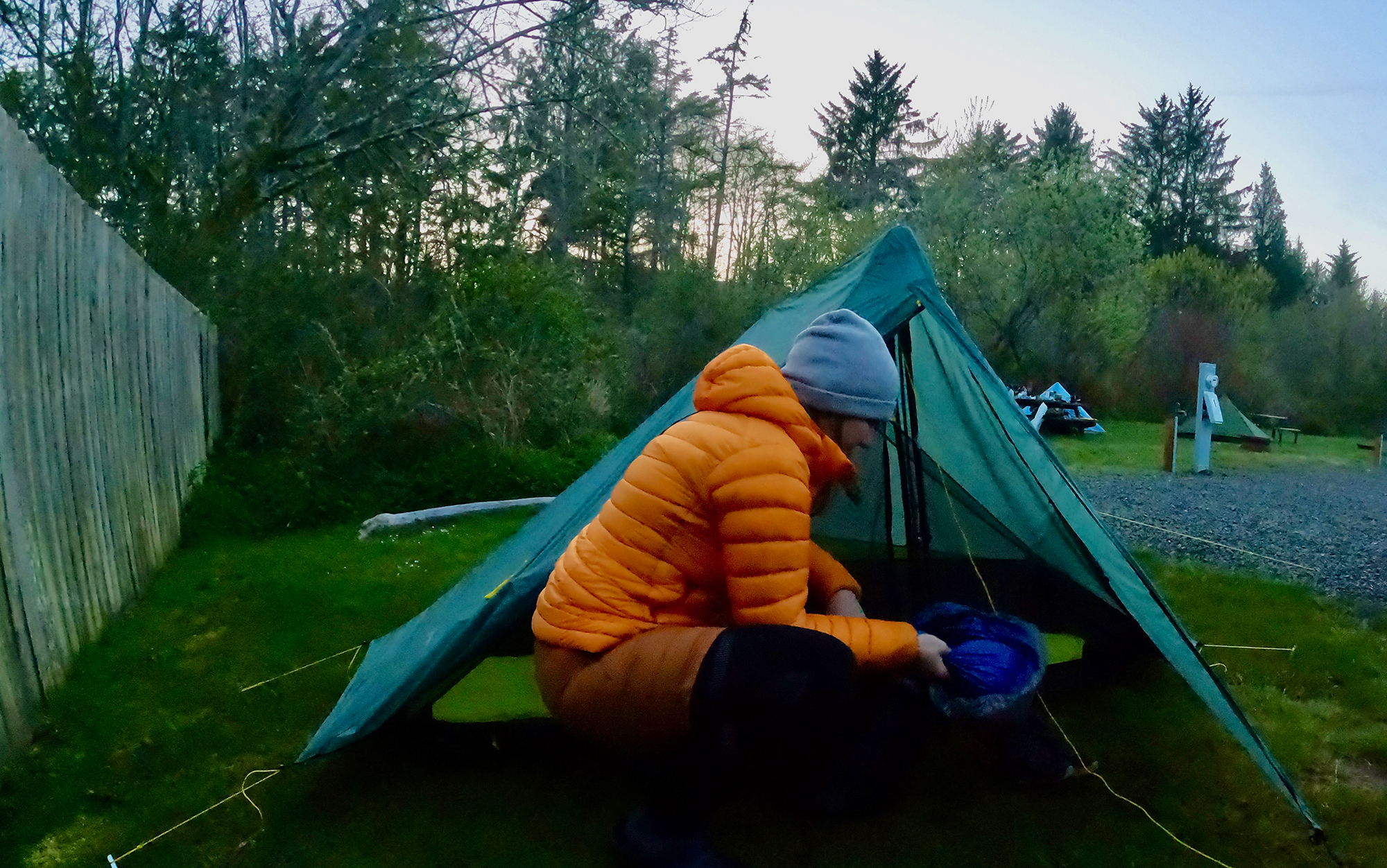
Happily, the interior was spacious and the low price coupled with low weight make this tent one to consider.
We struggled with the Kuiu Summit Star, which easily had the most complicated setup. Our most experienced tester spent forty minutes getting the pitch right on her first attempt, the longest she said she had ever spent setting up a new tent.
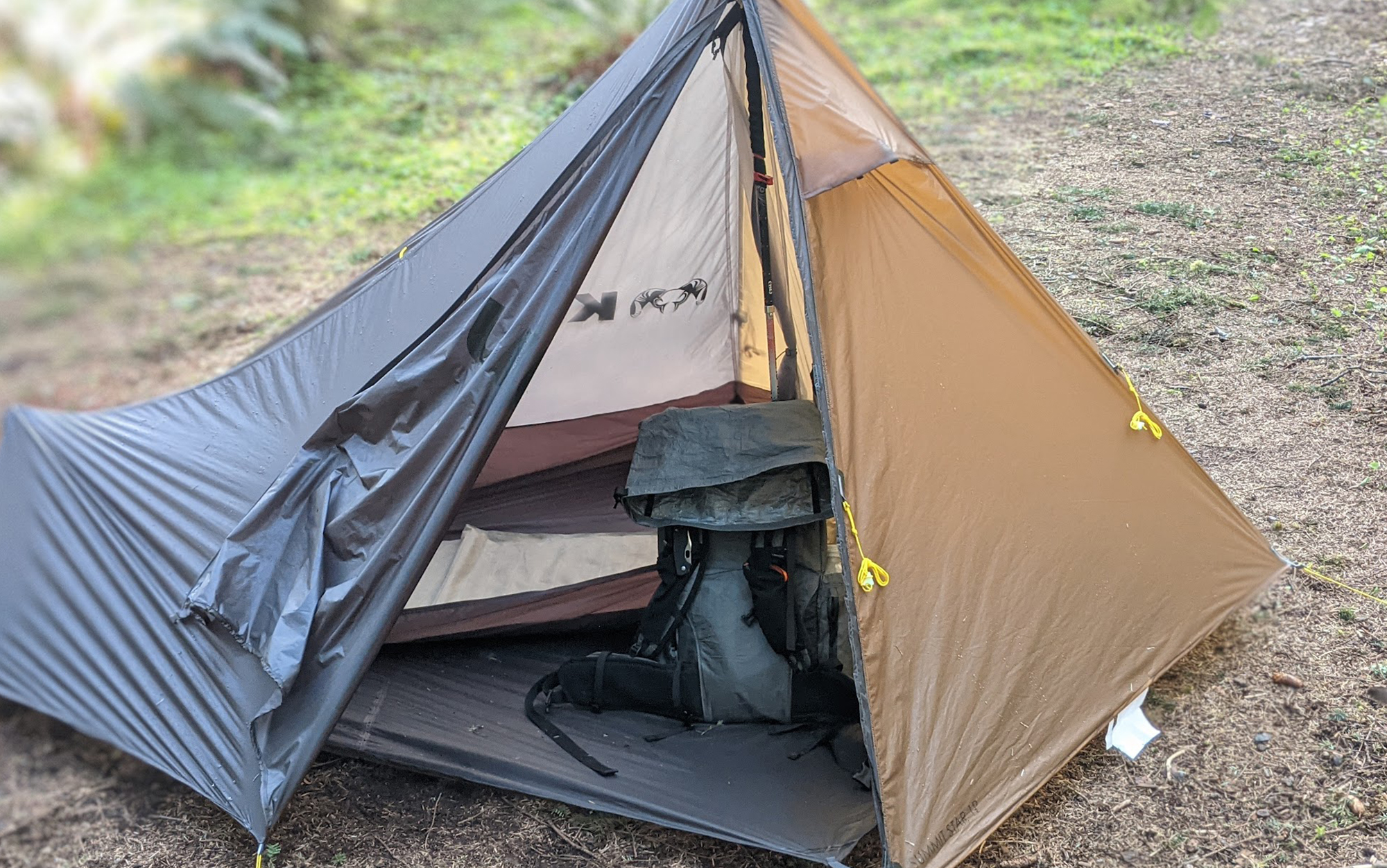
But there were details that stood out: an incredibly spacious vestibule (this was effectively the largest one-person ultralight tent we tested by a wide margin), great breathability, long length that will appeal to taller individuals, an optional vestibule floor. This would be the right choice for an especially patient individual looking for an ultralight basecamp. And it does look awfully sharp once it’s up.
The Samaya Opti 1.5 is one that we wanted to love. After all, this is the brand that brought us the Radical1, one of the best 4-season tents that weighs less than a pound and a half. And they were taking a different approach to the trekking pole setup here (external A-frame with a side entrance, easier to get in and out), which is always fun to play around with. Well, play around we did, but we just couldn’t get this tent to look right. We particularly struggled with the guyline on the back of the tent, which when pulled taut actually decreases the interior space of the tent. Surely an angle exists where this wouldn’t happen, but we did not find it during our test.
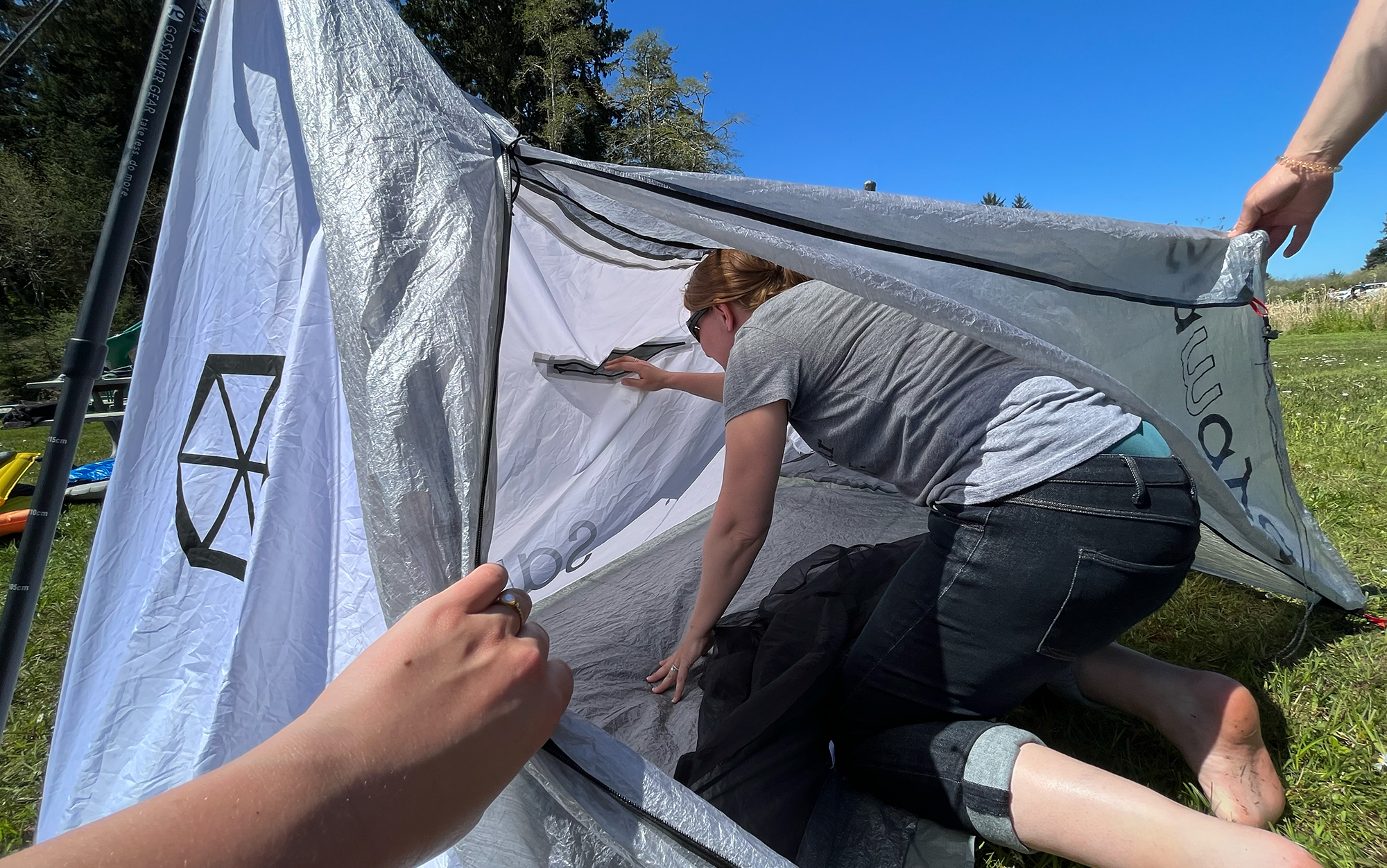
There were other problems too. The included stakes, the same as with the Radical1 that worked so well in snow, had poor hold in soft ground and bent when they hit hard ground. Adjusting the pitch of the trekking poles along the A-frame was also tricky, as pulling the guylines along the side taut tended to affect the angle and make the whole setup unstable. And while the vestibule was an impressive size, the advertised front porch option requires a second set of trekking poles — which you would only have if you were sharing this tent with another person. For us, this ultralight tent didn’t hit the mark (especially at this price point), but we’ll be watching to see what the innovative Samaya brand comes out with in the future.
How to Choose the Best Ultralight Tents
Semi-Freestanding versus Trekking Poles
For the uninitiated, semi-freestanding tents can stay up with just the poles inserted, no need to stake into the ground unless you want to maximize your floor space (or rain is in the forecast). Trekking-pole tents, on the other hand, must be staked out in order to stand up. For years, experienced backpackers would tend toward trekking-pole tents for the weight savings. Novice backpackers, on the other hand, would gravitate toward the simplicity and security of a semi-freestanding tent, which are easier to perfect the setup of.
In recent years, however, the difference in weight and ease of setup between freestanding and non-freestanding tents has started to shrink. Our pick for the best semi-freestanding tent, the MSR Freelite, weighed less than several trekking pole designs we looked at, while the single trekking pole design of the Six Moons Lunar Solo was nearly as easy to put up as a typical cross-pole construction.
Trekking Poles
If you currently use trekking poles, then switching to a tent that incorporates them into the design can be a major weight savings. (If you do not, then you’ll want to incorporate the weight of the trekking poles or the substitute tent poles into your calculations before making a final decision). When choosing an ultralight tent, check that your trekking poles extend up to the recommended height — our test of the best ultralight tents was paired with our test of the best trekking poles, and we were surprised at how often the trekking poles we were using were too short for the tents.
Ease of Setup
There is a lot of variation in how easy or difficult ultralight tents are to set up. Some tents, especially freestanding tents, are so simple to set up that you don’t even need directions. Others seem to require endless fiddling to achieve the ideal setup, especially the first few times you use them. If you regularly hike until dusk or are heading into a part of the country where snap storms are the norm, choosing a tent where you can achieve a great setup lightning fast is essential.
Single versus Double Wall
Most tents are double wall tents, where the inner mesh body and outer rainfly are two pieces separated by an inch or so when set up correctly. This helps to prevent condensation — the moisture that collects as we exhale during the night — from getting our gear wet when we brush up against the tent walls. However, extra material means extra weight, and ultralight purists typically opt for single wall tents that emphasize ventilation. However, as our extra condensation-prone backpacking gear test along the Oregon Coast showed, sometimes no amount of ventilation will prevent rapid condensation build up. So you’ll have to decide which is more important: protection from condensation or a lower weight.
Vestibule Size
For this test, we looked exclusively at one person tents, which generally lack the interior floor space for more than one of the best backpacking sleeping pads. With these tents, a healthy size vestibule is important if you are carrying more than the bare minimum of gear.
Seam Sealing
Seam sealing is essential to waterproofing the seams of a tent. Not all ultralight tents seam seal their tents automatically — some offer their tents at a lower price with the understanding that the consumer will seam seal it themselves. If you do not want to seam seal your own tent, double check whether this is provided automatically or as a separate service before purchasing.
Stakes
Lightweight stakes with excellent holding power are essential for non-freestanding tents. However, not all ultralight tents come with stakes at the point of purchase. Others don’t come with stakes that are appropriate for challenging terrains or conditions. I’ve noted in the above reviews where stakes will need to be purchased separately and when you should consider swapping out the provided stakes for one of the best tent stakes.
FAQs
Ultralight tents typically weigh between 1 and 2 pounds for a one-person model. A two-person ultralight tent will typically weigh about a pound more than their single person counterparts.
Ultralight tents are typically made from DCF (Dyneema Composite Fabric), silnylon, or silpolyester. Poles and stakes are generally made from lightweight aluminum (look for high quality poles, like those from DAC) or sometimes carbon fiber.
If you’re new to ultralight backpacking, it’s best to start with an ultralight tent. While tarps are an excellent ultralight option, their ability to handle certain weather conditions is limited and they require significantly more experience to achieve a weather-ready setup.
Final Thoughts
There has never been a better time to upgrade your backpacking tent to an ultralight model. The ingenuity and diversity of design and construction means that it’s easy to find a tent that fits your needs, current kit, and experience level. After testing these tents first-hand in the field, we’re confident that they’ll shave ounces (and even pounds) off your base weight while still providing the quality sleep you need to make the most of your next outdoor adventure.
Semi-Freestanding Tents
- Best Overall: MSR Freelite
- Best Upgrade: Zpacks Free Zip
- Mountain Hardwear Nimbus UL 2
- Big Agnes Fly Creek UL 2
Trekking-Pole Tents
- Best Overall: Gossamer Gear The ONE and The TWO
- Best Value: Durston X-Mid
- Lightest: Gossamer Gear Whisper
- Best for Tall People: Tarptent ProTrail
- Zpacks Plex Solo
- Seek Outside Sunlight
- Six Moons Lunar
- Six Moons Designs Havens Ultralight
The post The Best Ultralight Tents of 2024, Tested and Reviewed appeared first on Outdoor Life.
Source: https://www.outdoorlife.com/gear/best-ultralight-tents/

